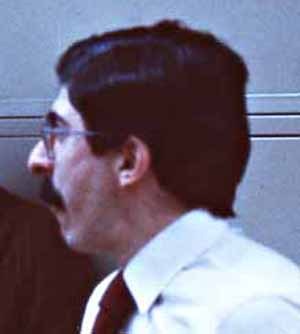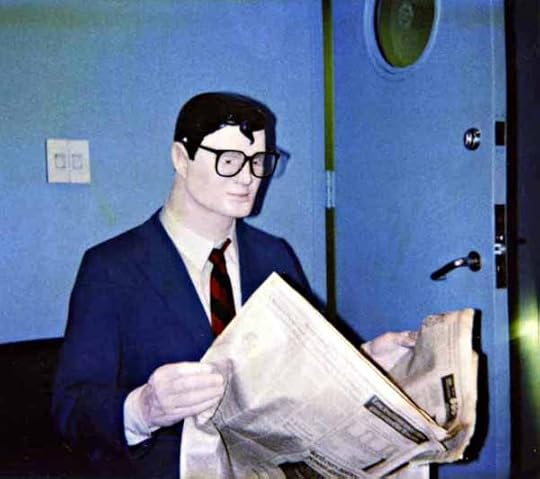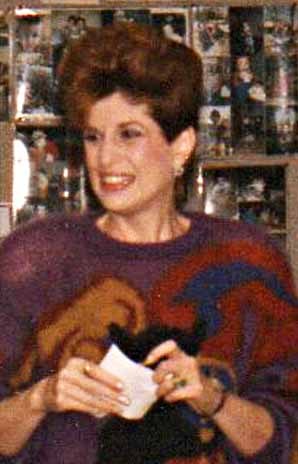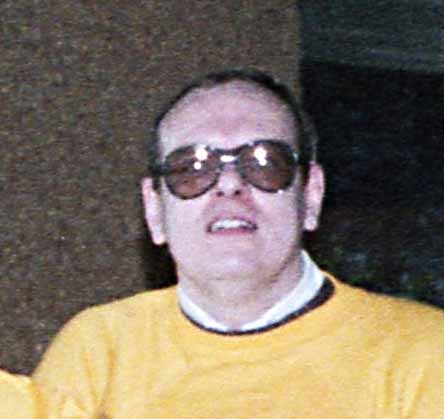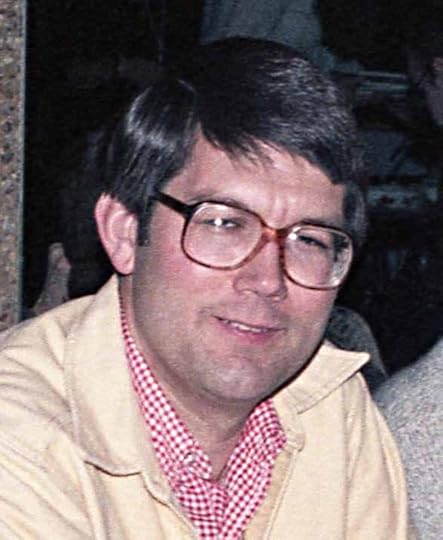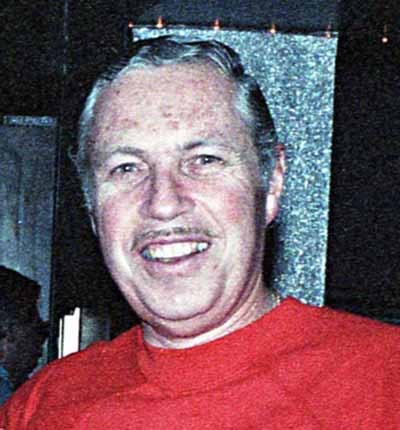Todd Klein's Blog, page 190
August 4, 2016
THE DC COMICS OFFICES 1982-1991 Part 4
 Here’s a floor plan of the DC Comics offices at 666 5th Avenue in the later half of the time there, from about 1986-1991, designed by Steven Bové with tweaking by me. Again, we have no actual plans to go by, this is based on the collective memories of staffers who worked there, including myself, Bob Rozakis, Richard Bruning, Bob Greenberger, Mike Carlin and many others. There are bound to be errors of proportion and perhaps even number of rooms in some places, but it’s reasonably close. I’ve put in a few names for those whose offices remained the same throughout the 666 years, but for some reason unknown to me, personnel changed locations often, making it hard to remember or pin down who was in each office or area. In the following article we’ll be referring to offices by room number, but memory is a tricky thing, and I’ve received some conflicting reports on who sat where, so we’ll just do the best we can.
Here’s a floor plan of the DC Comics offices at 666 5th Avenue in the later half of the time there, from about 1986-1991, designed by Steven Bové with tweaking by me. Again, we have no actual plans to go by, this is based on the collective memories of staffers who worked there, including myself, Bob Rozakis, Richard Bruning, Bob Greenberger, Mike Carlin and many others. There are bound to be errors of proportion and perhaps even number of rooms in some places, but it’s reasonably close. I’ve put in a few names for those whose offices remained the same throughout the 666 years, but for some reason unknown to me, personnel changed locations often, making it hard to remember or pin down who was in each office or area. In the following article we’ll be referring to offices by room number, but memory is a tricky thing, and I’ve received some conflicting reports on who sat where, so we’ll just do the best we can.
On the business side of things, it’s harder to track personnel except for those at the top level, who sometimes appeared on the indicia page of collected editions beginning around 1987. Some of the lower level workers in areas like Marketing, Circulation and Accounting did not get their names in print or identified in photos I have, and unfortunately can’t be included here.
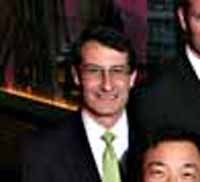
Speaking of the business side, Ed Shukin appears as Vice President – Circulation and Patrick Caldon as Controller in the 1987 Graphitti Designs hardcover edition of BATMAN: THE DARK KNIGHT. Shukin came from a similar role at Marvel. I have no information on Caldon, but he probably replaced longtime head of DC Accounting Arthur Gutowitz. Caldon, still with the company in 2010, is shown in a photo of that vintage above, I haven’t found one of Shukin.
 Linda Robak, 1985, photo by Tom Mason.
Linda Robak, 1985, photo by Tom Mason.
Linda Robak followed Mike Flynn as Advertising and Sales Manager from 1984-1986, working alongside Peggy (May) Ordway. Both worked under Bruce Bristow, who remained the Marketing Director for most or all of the 666 years.
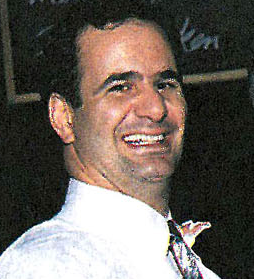 Here’s Matt Ragone who may have replaced Ed Shukin by 1988, when he’s first listed as Circulation Manager. Photo from 1994 by Justin Nisbet.
Here’s Matt Ragone who may have replaced Ed Shukin by 1988, when he’s first listed as Circulation Manager. Photo from 1994 by Justin Nisbet.
 In 1987, Bob Wayne joined the DC sales team, and over the next few decades helped shape the direct market for selling comics as we know it today. He retired in 2014. Undated photo found online.
In 1987, Bob Wayne joined the DC sales team, and over the next few decades helped shape the direct market for selling comics as we know it today. He retired in 2014. Undated photo found online.
Other business personnel names I have without pictures are Marilyn Drucker, Licensing and Tom Ballou, Advertising Director (hired in 1988).
 Before going further, I have to acknowledge this article by Robert Greenberger in BACK ISSUE #80, May 2015. It covers written or transcribed remembrances by staffers of many of the office locations, including 666 5th Avenue. I’ve already quoted from it a bit, with permission from everyone involved, and will do so more heavily in this part of my article. Thanks to Bob, magazine editor Michael Eury, and those quoted.
Before going further, I have to acknowledge this article by Robert Greenberger in BACK ISSUE #80, May 2015. It covers written or transcribed remembrances by staffers of many of the office locations, including 666 5th Avenue. I’ve already quoted from it a bit, with permission from everyone involved, and will do so more heavily in this part of my article. Thanks to Bob, magazine editor Michael Eury, and those quoted.
 Many who visited the offices were amazed, stunned, or otherwise assaulted by the loud yellow-dotted wallpaper, modeled here for us by Production Manager Bob Rozakis, and clearly triumphing over his Hawaiian shirt. Indeed, photos don’t really capture its bright golden yellow brilliance. Former editor Mark Waid reports that it was designed by famed graphic designer Milton Glaser, a friend of publisher Jenette Kahn, at her request. Glaser had also designed the DC Bullet symbol for her, the fifth one in the logo lineup above, as well as revamping the Superman and Wonder Woman logos (or at least, his studio did). The wallpaper was the kind of thing that probably looked like a fun idea small, but when enlarged to wall size became the stuff of headaches and nightmares. Waid reports that Jenette had extra rolls stashed in her office in case of damage or perhaps an employee berserk rage event. Fortunately it was mostly on the hallway walls, not in the rooms and offices.
Many who visited the offices were amazed, stunned, or otherwise assaulted by the loud yellow-dotted wallpaper, modeled here for us by Production Manager Bob Rozakis, and clearly triumphing over his Hawaiian shirt. Indeed, photos don’t really capture its bright golden yellow brilliance. Former editor Mark Waid reports that it was designed by famed graphic designer Milton Glaser, a friend of publisher Jenette Kahn, at her request. Glaser had also designed the DC Bullet symbol for her, the fifth one in the logo lineup above, as well as revamping the Superman and Wonder Woman logos (or at least, his studio did). The wallpaper was the kind of thing that probably looked like a fun idea small, but when enlarged to wall size became the stuff of headaches and nightmares. Waid reports that Jenette had extra rolls stashed in her office in case of damage or perhaps an employee berserk rage event. Fortunately it was mostly on the hallway walls, not in the rooms and offices.
 Mark Waid joined the staff in early 1988, and supplied this photo of his office at #47 on the floor plan, one of the new offices constructed some time during the mid 1980s. Of this office, Mark wrote in BACK ISSUE:
Mark Waid joined the staff in early 1988, and supplied this photo of his office at #47 on the floor plan, one of the new offices constructed some time during the mid 1980s. Of this office, Mark wrote in BACK ISSUE:
“I shared my first office with (designer) Julia Sabbagh. It was small, at the end of the editorial hall, about as far removed as it could be, but I didn’t care. I was elated. I’d inherited the late E. Nelson Bridwell’s desk. That first morning, I went to hang my coat up on the door-back coat hook and was puzzled by a slightly dark coat-shaped silhouette already there. Julia explained that that shape marked where Nelson had hung his coat every single day, summer or winter, for years and years. She called it the Shroud of Nelson.”
Bridwell passed away in January of 1987. Waid later sat in #21, the “Bullpen office,” and #45. Here’s a description written by Mark of his first visit to 666 in 1984 from the BACK ISSUE article:
“In September of 1984, I was a fanzine writer and editor who’d been invited by SUPERMAN editor Julius Schwartz to pitch some story ideas. In my enthusiasm, of course, I arrived something like five hours early and Bob Greenberger and Barbara (then Randall) Kesel took me under their wing and showed me around, and no child’s visit to Disneyland was ever more special than that visit to me.
“A very charming woman named Ruthie Thomas worked reception—a small waiting area where visitors sat next to a statue of Clark Kent reading the Daily Planet. (Ruthie was great.) Through the top half of the always-open Dutch door that gated reception from the main office, you could see a little bit of office buzz, but not until she allowed you access were you in the thick of it.
“Just past reception was a short hallway maybe 30 feet long (newsstand circulation offices on the left, marketing offices on the right). At the end of the hall, a left would take you to the executive offices of Paul Levitz and Jenette Kahn and to the library.
 Left, my own bound volumes in the same style as those in the DC Library. Right, a look inside a bound volume of ADVENTURE COMICS, image found online. Mark Waid continues:
Left, my own bound volumes in the same style as those in the DC Library. Right, a look inside a bound volume of ADVENTURE COMICS, image found online. Mark Waid continues:
“I will never, ever forget what it felt like to step into that library for the very first time. Remember, this was before the Internet, before Google images, before most of DC’s publishing history had been fully mined and all its covers and back issues could be easily found, or even readily seen. When I walked into that library, full of floor-to-ceiling metal cabinets filled with bound volumes of everything DC had ever published, I nearly passed out. I’m not kidding. It’s the closest I’ve ever come in my life to blacking out simply through excitement.”
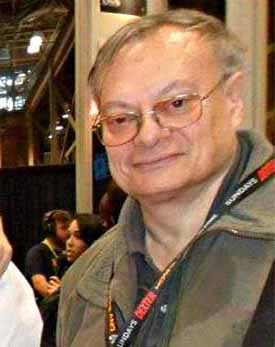 Well said, Mark! I felt exactly the same way when I first entered the library myself in 1977 (at the previous offices). And as the library was not staffed then, I was allowed in there by myself during lunch breaks to browse, and even allowed to take bound volumes home to read. I read the entire runs of MYSTERY IN SPACE and STRANGE ADVENTURES that way. Things changed at 666, library security was tighter. I’m not sure if Allan Asherman had become the staff librarian when Mark visited in 1984, but that happened some time in the mid 1980s. Here’s the only photo I can find of Allan by Bob Rozakis from 2011. Asherman held forth as company historian and library protector for decades, after an early career as a comics fan and writer. I believe he was in office #23, which became a closed-in portal to the library.
Well said, Mark! I felt exactly the same way when I first entered the library myself in 1977 (at the previous offices). And as the library was not staffed then, I was allowed in there by myself during lunch breaks to browse, and even allowed to take bound volumes home to read. I read the entire runs of MYSTERY IN SPACE and STRANGE ADVENTURES that way. Things changed at 666, library security was tighter. I’m not sure if Allan Asherman had become the staff librarian when Mark visited in 1984, but that happened some time in the mid 1980s. Here’s the only photo I can find of Allan by Bob Rozakis from 2011. Asherman held forth as company historian and library protector for decades, after an early career as a comics fan and writer. I believe he was in office #23, which became a closed-in portal to the library.
 Here’s Barbara (Randall) Kesel and her mother on the couch in front of the Cover Wall in the middle of the Editorial section of the offices, marked “covers” in the floor plan, photo supplied by Barbara. Mark Waid writes of it:
Here’s Barbara (Randall) Kesel and her mother on the couch in front of the Cover Wall in the middle of the Editorial section of the offices, marked “covers” in the floor plan, photo supplied by Barbara. Mark Waid writes of it:
“Dead-center in the editorial end of the hall, just outside a small coffee room, there was a large communal area with a couch where the freelancers tended to congregate, the restrooms nearby. Above the couch, push-pinned to the wall, was (arranged neatly week-by-week) a copy of every comics cover being printed that month—a good space to have so editors could see the line at a glance, and be careful not to accidentally repeat any upcoming cover designs.”
I agree with all that except for the description of “large.” It may only have been considered large compared to some of the editor’s offices. I mean, that couch seats three people at best, and you can see from the wall corner on the right there’s not a lot of hall in front of it.
 Looking the other way from that point, here’s the tiny coffee room, #29, in the background behind editor Archie Goodwin wearing a Donald Duck hat. No idea why, but it reminds me of how funny Archie could be. Photo by Curtis King. Archie had two stints as editor at DC, the first in the early 1970s, the second beginning in 1990, the date of this photo. He was considered by many, including myself, one of the best editors ever in comics.
Looking the other way from that point, here’s the tiny coffee room, #29, in the background behind editor Archie Goodwin wearing a Donald Duck hat. No idea why, but it reminds me of how funny Archie could be. Photo by Curtis King. Archie had two stints as editor at DC, the first in the early 1970s, the second beginning in 1990, the date of this photo. He was considered by many, including myself, one of the best editors ever in comics.
The coffee room was a source of continual sniping, as I recall. Most people wanted coffee but were annoyed if they had to make it. Heaven help us if we ran out of coffee, see above. There was a small refrigerator where some employees would put their bagged lunches and snacks, and occasionally food went missing. (I wish to cast no aspersions, but possibly having the coffee room near the place where many freelancers hung out was not the wisest choice?)
Just to the left of this picture was the door to the small ladies’ room, #38 (you can see part of that door in the photo above. I’ve had a several former staffers tell me the ladies’ room didn’t exist when they were there. All were male. They had no trouble remembering the men’s room, #39. As Bob Rozakis told me:
“There had to be a ladies room—single occupancy—because there is no way, politically or legally, that there could be a men’s room without a mate. And a unisex bathroom would have been unheard of at the time. Also, I specifically recall one day when Carol Fein insisted on using the men’s room because someone had taken up residence in the ladies room and she could not wait.”
The area marked 31 and Fedex was where editorial photocopying and shipping happened, with a young staffer to handle that. Bob Greenberger remembers some of the people in that location and position as Eddie Berganza, Mike McAvennie, Frank Pittarese and Dan Thorsland, all of whom moved up to editing later. In the 666 years, shipping art by Fedex became ever more popular, especially when DC paid the shipping bills. Fedex was usually much faster and more reliable than regular mail then, and at Warner Communications corporate rates, not too costly. Fedex allowed freelancers to spread out across the country and across the world without missing deadlines, assuming they got the work done in the first place.
 Two new editors were hired in 1983, Alan Gold and Janice Race, seen here in 1984 and 1983 photos by Albert DeGuzman. Alan remembers in BACK ISSUE:
Two new editors were hired in 1983, Alan Gold and Janice Race, seen here in 1984 and 1983 photos by Albert DeGuzman. Alan remembers in BACK ISSUE:
“I (and Janice Race) were hired, I was told, because managers (I’m guessing Dick Giordano) were frustrated by the incompetence and indifference of the fanboys and selfish hacks (who were only concerned with their own projects and ‘worked’ on staff for pocket change and a place for schmoozing and self-aggrandizing); they hired us because we were book professionals, ‘grownups’ used to and serious about schedules and standards. Dick was right about us. We got most of our books out on time.”
 Alan began in the summer of 1983 and stayed at DC until fall of 1986. Janice Race is holding the art for THE FURY OF FIRESTORM #21 cover dated March 1984, probably one of the early things she worked on in the fall of 1983 when she started. Her name began appearing as editor on the next issue. Janice shared office #18 with Len Wein after Nick Cuti moved next door to #21, and Alan Gold started in office #21. He recently told me, “My first roommate was Roger Slifer. Later I shared a room with Bob Greenberger, and finally I shared a closet (no windows) with cover designer Ed Hannigan.” That would have been one of the small offices at lower right on the floor plan. Janice Race worked at DC until about Oct. 1986. Janice remembered in BACK ISSUE: “A thing that amazed me was how Len and Marv and Mike Barr could argue like crazy and then at the end of the day get together to decide which movie they were going to see that night.”
Alan began in the summer of 1983 and stayed at DC until fall of 1986. Janice Race is holding the art for THE FURY OF FIRESTORM #21 cover dated March 1984, probably one of the early things she worked on in the fall of 1983 when she started. Her name began appearing as editor on the next issue. Janice shared office #18 with Len Wein after Nick Cuti moved next door to #21, and Alan Gold started in office #21. He recently told me, “My first roommate was Roger Slifer. Later I shared a room with Bob Greenberger, and finally I shared a closet (no windows) with cover designer Ed Hannigan.” That would have been one of the small offices at lower right on the floor plan. Janice Race worked at DC until about Oct. 1986. Janice remembered in BACK ISSUE: “A thing that amazed me was how Len and Marv and Mike Barr could argue like crazy and then at the end of the day get together to decide which movie they were going to see that night.”
 Here’s Janice in 1983 with editors Len Wein and Karen Berger, as well as production artist Albert DeGuzman, who provided the photo, probably taken in Len and Janice’s office.
Here’s Janice in 1983 with editors Len Wein and Karen Berger, as well as production artist Albert DeGuzman, who provided the photo, probably taken in Len and Janice’s office.
 Another feature of the office design I haven’t mentioned yet were the word-balloon shaped name tags outside office doors. You can see one above for Joe Orlando in this photo of artist Denys Cowan by Curtis King from 1990.
Another feature of the office design I haven’t mentioned yet were the word-balloon shaped name tags outside office doors. You can see one above for Joe Orlando in this photo of artist Denys Cowan by Curtis King from 1990.
Not a good image, but the best I have. When plans for the move were being made in 1982, I was asked by Design Director Neal Pozner to letter all the staff names for those. I really didn’t want the job, as I knew it would be an endless task, and Neal was such a perfectionist that I also knew he’d constantly be wanting to tweak every name and letter. I did a few samples, but when Neal came back with changes, I took myself off the job and recommended Gaspar Saladino, who did the initial name lettering. Gaspar was a freelancer, and not always available when new personnel were hired, so later names were often added by whoever was available, I think. Originally the names were inscribed on plastic strips that slid into upper and lower slots of the thick yellow plastic balloon, but over time they stopped spending money on those and would just stick new names up any old way, as here. Another fun design idea that didn’t work well in practice, or look very good in general, and there were other issues with it. Barbara Randall Kesel remembers, “We all had little yellow word-balloon name tags. My name didn’t fit.”
 Paul Kupperberg, 1982, image found online.
Paul Kupperberg, 1982, image found online.
Paul Kupperberg had been on staff in the Marketing department at 75 Rockefeller Plaza, but we think he left that position before the move to 666. He writes:
“I went back on staff in Editorial briefly in the 1980s—1984 or 85?—I did some hands-on editing on BATMAN: THE DARK KNIGHT RETURNS for Dick Giordano during that time. I shared an office with Len Wein, #18 on the floor plan. For my last 16-year run at DC, I started the week AFTER the move to 1325 Avenue of the Americas.”
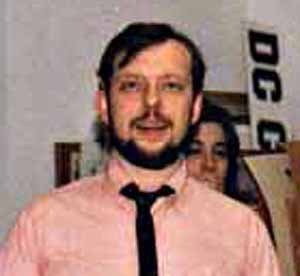 Some time in 1985, Neal Pozner left staff, though he continued to do some freelance work for the company, and was replaced by Richard Bruning, seen here in a 1985 photo by Albert DeGuzman. Richard told me, “I got what I believe was Neal’s office. It almost went to someone in Marketing, but I talked them out of that.” Richard’s title was originally Art Director, and he worked on all aspects of the DC look from covers to logos to trade dress, as Neal had. Richard also did some writing and editing for the company. He was later promoted to Design Director. He left in 1990, but returned to DC in 1996 as Vice President—Creative Director until 2010. He’s perhaps best known for the cover design work on WATCHMEN with artist Dave Gibbons, and the Vertigo logo.
Some time in 1985, Neal Pozner left staff, though he continued to do some freelance work for the company, and was replaced by Richard Bruning, seen here in a 1985 photo by Albert DeGuzman. Richard told me, “I got what I believe was Neal’s office. It almost went to someone in Marketing, but I talked them out of that.” Richard’s title was originally Art Director, and he worked on all aspects of the DC look from covers to logos to trade dress, as Neal had. Richard also did some writing and editing for the company. He was later promoted to Design Director. He left in 1990, but returned to DC in 1996 as Vice President—Creative Director until 2010. He’s perhaps best known for the cover design work on WATCHMEN with artist Dave Gibbons, and the Vertigo logo.
Neal Pozner also returned to DC from about 1990 to 1994 as Group Editor, Creative Services. At that time he was instrumental in recruiting new talent, some of whom have become industry stars.
 Here’s Barbara Kesel in her first office, #21 on the floor plan. She remembers in BACK ISSUE:
Here’s Barbara Kesel in her first office, #21 on the floor plan. She remembers in BACK ISSUE:
“I started out in the bullpen office (shared with Marv Wolfman, Bob Greenberger and Alan Gold) next to where the freelancers turned in their vouchers, which meant I’d come back from lunch to find some freelancer or Mark Hamill had taken over my desk and run off with all the pens. Two offices later, I shared a space the size of a Diet Coke case with Mark Waid. (Then) I was moved to what had been Sal Amendola’s desk packed full of submissions for NEW TALENT SHOWCASE. They filled the drawers, were stacked on top, and piled by the sides. Which is how I became the de facto assistant editor for that title—if I wanted drawers, I had to empty them.”
 Another photo of Barbara looking fiercely at photographer Mike Carlin. Barbara remembers being moved a number of times, first to room 47 with Nick Cuti, then back to room 21, then into 45, which she shared with Mark Waid.
Another photo of Barbara looking fiercely at photographer Mike Carlin. Barbara remembers being moved a number of times, first to room 47 with Nick Cuti, then back to room 21, then into 45, which she shared with Mark Waid.
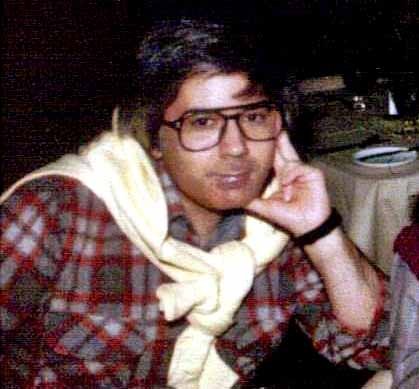 Sal Amendola, seen here in a 1985 photo by Bob Rozakis, joined the DC staff as a part-time editor near the end of 1984. He was also teaching at the School of Visual Arts, and had a mandate to work with new talent, which he did on NEW TALENT SHOWCASE and ELVIRA’S HOUSE OF MYSTERY while they lasted. He left staff in the spring of 1986. His office was probably #45.
Sal Amendola, seen here in a 1985 photo by Bob Rozakis, joined the DC staff as a part-time editor near the end of 1984. He was also teaching at the School of Visual Arts, and had a mandate to work with new talent, which he did on NEW TALENT SHOWCASE and ELVIRA’S HOUSE OF MYSTERY while they lasted. He left staff in the spring of 1986. His office was probably #45.
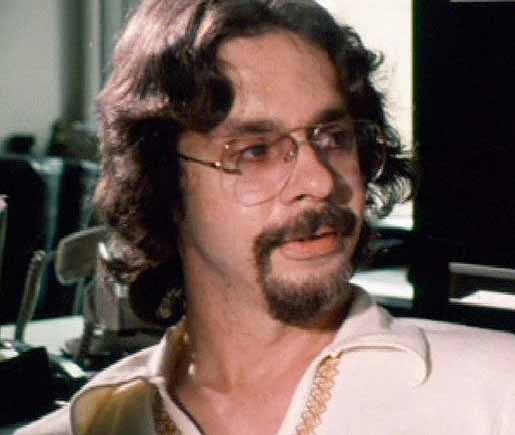 Cary Bates, seen here in an undated photo found online, had been writing for DC for years, and in the fall of 1983 he began editing THE FLASH, a title he was also writing. He was a part-time editor on just that title, and continued to be until the summer of 1985.
Cary Bates, seen here in an undated photo found online, had been writing for DC for years, and in the fall of 1983 he began editing THE FLASH, a title he was also writing. He was a part-time editor on just that title, and continued to be until the summer of 1985.
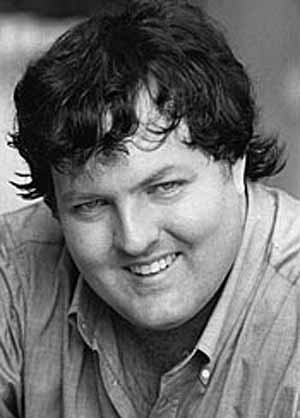 Mark Evanier was another comics writer given the editorial reins of a book he was writing, BLACKHAWK, from about November 1983 to November 1984, undated photo found online. Mark lived in California, so would not have had office space.
Mark Evanier was another comics writer given the editorial reins of a book he was writing, BLACKHAWK, from about November 1983 to November 1984, undated photo found online. Mark lived in California, so would not have had office space.
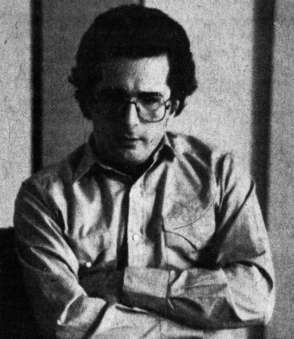 Writer Michael Fleisher had been working for DC for many years, and in early 1984 began editing JONAH HEX, a title he was writing. That continued with a relaunch called simply HEX until it ended in early 1987.
Writer Michael Fleisher had been working for DC for many years, and in early 1984 began editing JONAH HEX, a title he was writing. That continued with a relaunch called simply HEX until it ended in early 1987.
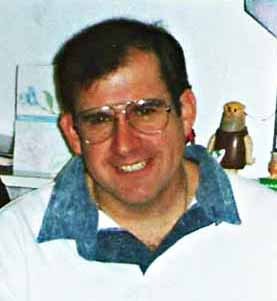 Mike W. Barr, seen here in a photo from Michael Eury, had worked on staff as an editor at DC in 1981-82, then left to write full-time. In the spring of 1984 he returned as a part-time editor for books he was writing, and visited the offices regularly. That lasted until the spring of 1987.
Mike W. Barr, seen here in a photo from Michael Eury, had worked on staff as an editor at DC in 1981-82, then left to write full-time. In the spring of 1984 he returned as a part-time editor for books he was writing, and visited the offices regularly. That lasted until the spring of 1987.
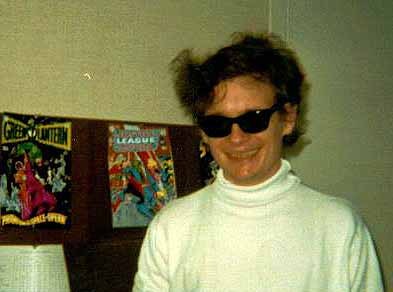 Dennis “Denny” O’Neil, seen here in an early 1970s photo by Jerry Bails, had two stints as editor at DC, the first from 1972 to 1973, the second beginning in early 1986 and continuing until his retirement around 2003. For much of that time he was the Batman editor or group editor.
Dennis “Denny” O’Neil, seen here in an early 1970s photo by Jerry Bails, had two stints as editor at DC, the first from 1972 to 1973, the second beginning in early 1986 and continuing until his retirement around 2003. For much of that time he was the Batman editor or group editor.
 Bob Greenberger in a 1985 photo by Albert DeGuzman.
Bob Greenberger in a 1985 photo by Albert DeGuzman.
Robert (Bob) Greenberger remembered in his BACK ISSUE article:
“When I was hired for good in 1984, the staff continued to grow and no matter how they rearranged the space, it was never enough. When I arrived I had a half-desk (in office #21), formerly used by part-time editor Marv Wolfman, sandwiched between Alan Gold and Karen Berger. In time, I took over Karen’s desk and when Alan moved on, I shared the room with Mark Waid and then Barbara Kesel and others. I didn’t have a place to call my own until I became Editorial Coordinator.”
That latter job involved lettering and coloring assignments, which meant I saw and heard a lot from Bob, who was always helpful and generous with work assignments.
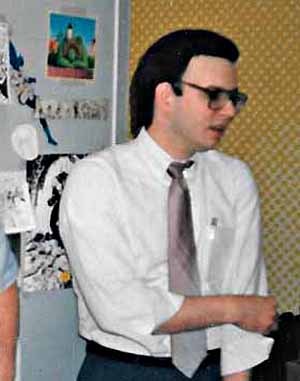 Jonathan Peterson. seen here in a photo by Mike Carlin, joined DC as an assistant editor in the summer of 1986, and before long was editing his own titles.
Jonathan Peterson. seen here in a photo by Mike Carlin, joined DC as an assistant editor in the summer of 1986, and before long was editing his own titles.
 Mike Carlin in his last office, photo supplied by him.
Mike Carlin in his last office, photo supplied by him.
Mike Carlin moved over to DC from Marvel in 1986, and his office was a magnet for famous guests, freelancers and foolery for many years. Mike reports that he was in office #41 first (and hated being next to the Men’s Room), then shared #18 with Denny O’Neil, and finally moved to #47. He became the Superman group editor after the retirement of Julie Schwartz in 1986, following a transitional time when Andy Helfer edited SUPERMAN. Here are a few pictures supplied by Mike and others:
 Comedian Dana Carvey with Carlin and Clark Kent in the DC reception area.
Comedian Dana Carvey with Carlin and Clark Kent in the DC reception area.
 Carlin with Alex Winter of “Bill and Ted’s Excellent Adventure.”
Carlin with Alex Winter of “Bill and Ted’s Excellent Adventure.”
 Carlin with his assistant Jonathan Peterson, photo by Jerry Ordway.
Carlin with his assistant Jonathan Peterson, photo by Jerry Ordway.
 Karl Kesel, Barbara Randall Kesel and Carlin in his office in room #18, Denny O’Neil in the background, photo by Jerry Ordway.
Karl Kesel, Barbara Randall Kesel and Carlin in his office in room #18, Denny O’Neil in the background, photo by Jerry Ordway.
By the way, have you noticed how many people remember being in office #47 in the New Construction area? Ed Hannigan also told me his office was there. Two remember being in #45, one in #41. No one remembers being in offices 42, 43, 44 or 46. Possibly we have the number of rooms wrong there, or some of those offices were divided later. Possibly a few folks are off by one room or another. Memory is, indeed, a tricky thing.
Here’s a rundown of who edited which DC comics with April 1986 cover dates, to fill out the editorial picture.
JULIUS SCHWARTZ: Action Comics, DC Comics Presents, Shadow of the Batman, Superman
ALAN GOLD: ‘Mazing Man, Blue Devil, Omega Men
ROY THOMAS: All-Star Squadron, Infinity Inc., Secret Origins
KAREN BERGER: Amethyst Princess of Gemworld, Tales of the Legion of Super-Heroes, The Legion of Super-Heroes, Legionnaires 3, Swamp Thing.
NEAL POZNER & DICK GIORDANO: Aquaman
DICK GIORDANO & DENNIS O’NEIL: Batman, The Dark Knight Returns
LEN WEIN: Batman, Detective Comics
MIKE W. BARR: Batman and the Outsiders, The Outsiders
BARBARA KESEL: The Best of DC (digest)
JANICE RACE: Booster Gold, The Fury of Firestorm
BOB GREENBERGER: DC Challenge, Star Trek, V
JANICE RACE & RICHARD BRUNING: Deadman
SAL AMENDOLA: Elvira’s House of Mystery
ANDREW HELFER: Green Lantern, Justice League of America
MICHAEL FLEISHER: Hex
MARV WOLFMAN: Vigilante, The New Teen Titans, Tales of the New Teen Titans (with Barbara Kesel and George Perez)
JOE KUBERT: Sgt. Rock
WHO’S WHO IN THE DC UNIVERSE: Wein, Wolfman & Greenberger
As before, titles that did not see print that month are not included.
Next time I’ll continue with fun events in the production room, and more new faces. Other parts of the article, and more you might enjoy, can be found on the COMICS CREATION page of my blog.
August 3, 2016
THE DC COMICS OFFICES 1982-1991 Part 3
 Here’s a floor plan of the DC Comics Production Department in the 1980s, designed by Steven Bové with some tweaking by me. Most of this layout remained the same through the 666 5th Avenue years, though there may have been fewer drawing boards in the beginning, and a small separate office for the Assistant Production Manager was added at upper left around 1988-89. Again, I have no actual plans, this is assembled from the collective memories of myself and other staffers, and may well have errors in proportion and details, but it’s reasonably close, and in this case supported by photos. You entered the area through a doorway from the main hall at the top. Nearly everyone in the company came to use our copier just inside the door from time to time, though there were others. The tall cabinets opposite were standard five-drawer filing cabinets on the bottom with sliding door cabinets above. The file cabinets held all the logos, trade dress, and reference photostats from previous comics — anything that might need to be used again — going back in some cases to the 1950s. The sliding door cabinets held drawing paper for artists, among other things. Next to that was a coat closet, then a small sink needed for washing brushes and pens, then another tall cabinet full of supplies.
Here’s a floor plan of the DC Comics Production Department in the 1980s, designed by Steven Bové with some tweaking by me. Most of this layout remained the same through the 666 5th Avenue years, though there may have been fewer drawing boards in the beginning, and a small separate office for the Assistant Production Manager was added at upper left around 1988-89. Again, I have no actual plans, this is assembled from the collective memories of myself and other staffers, and may well have errors in proportion and details, but it’s reasonably close, and in this case supported by photos. You entered the area through a doorway from the main hall at the top. Nearly everyone in the company came to use our copier just inside the door from time to time, though there were others. The tall cabinets opposite were standard five-drawer filing cabinets on the bottom with sliding door cabinets above. The file cabinets held all the logos, trade dress, and reference photostats from previous comics — anything that might need to be used again — going back in some cases to the 1950s. The sliding door cabinets held drawing paper for artists, among other things. Next to that was a coat closet, then a small sink needed for washing brushes and pens, then another tall cabinet full of supplies.
 The most memorable thing in the room’s design was the rotating door into the Stat Room (#15), sometimes called The Transporter, where Shelley Eiber and others, made photostats for the production staff of logos, trade dress, artwork, and anything needed to put together comics covers and interior pages. The previous darkroom at 75 Rockefeller Plaza had a regular door with a red light over it that Shelley could put on when she was developing film or photostats, but it wasn’t always heeded. The revolving door ensured that nothing being developed could be ruined by outside light, and of course the stat room was lit with non-photo red light when developing happened. Shelley remembers having to caution people not to write notes to her in red because she couldn’t see that color when the red lights were on. Other parts of the production room, as shown, were flat files for storage topped by counters, and other storage areas and shelves. In the bottom left corner was the old Varityper Headliner machine, the only method we had for setting headline type (one letter at a time) photographically. Desktop computer graphics would soon make it obsolete.
The most memorable thing in the room’s design was the rotating door into the Stat Room (#15), sometimes called The Transporter, where Shelley Eiber and others, made photostats for the production staff of logos, trade dress, artwork, and anything needed to put together comics covers and interior pages. The previous darkroom at 75 Rockefeller Plaza had a regular door with a red light over it that Shelley could put on when she was developing film or photostats, but it wasn’t always heeded. The revolving door ensured that nothing being developed could be ruined by outside light, and of course the stat room was lit with non-photo red light when developing happened. Shelley remembers having to caution people not to write notes to her in red because she couldn’t see that color when the red lights were on. Other parts of the production room, as shown, were flat files for storage topped by counters, and other storage areas and shelves. In the bottom left corner was the old Varityper Headliner machine, the only method we had for setting headline type (one letter at a time) photographically. Desktop computer graphics would soon make it obsolete.
 Production Manager Bob Rozakis had an office at the top of the floor plan, with a desk (marked #1) and a guest chair for visitors. There were glass windows on the side facing the production room. He’s seen here in a 1983 photo by Albert DeGuzman marking up printer or separation proofs for a comic while talking on the phone, multitasking, as we all did. Bob joined the DC staff in the summer of 1973 and began selling stories to them soon after. He’s often remembered as the author and personality of DC’s “Answer Man” column, and for his comics series ‘MAZING MAN with Stephen DeStefano. On the wall behind him are production/printing schedules.
Production Manager Bob Rozakis had an office at the top of the floor plan, with a desk (marked #1) and a guest chair for visitors. There were glass windows on the side facing the production room. He’s seen here in a 1983 photo by Albert DeGuzman marking up printer or separation proofs for a comic while talking on the phone, multitasking, as we all did. Bob joined the DC staff in the summer of 1973 and began selling stories to them soon after. He’s often remembered as the author and personality of DC’s “Answer Man” column, and for his comics series ‘MAZING MAN with Stephen DeStefano. On the wall behind him are production/printing schedules.
Out of sight to the left of this photo was a rack for comics art that had been turned in by Editorial, ready to be worked on. Most of the production artists worked on these interior pages, adding things like the indicia and logos, doing any art and lettering corrections requested in blue pencil by the editor, and prepping the book for printing. When you were done with one you took it to the editor for checking and then picked up the next book in the rack from Bob’s office. A similar process happened for covers.
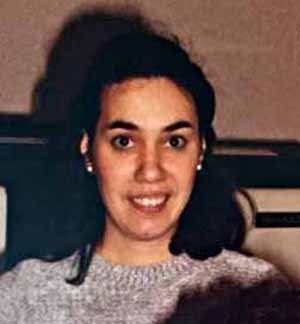 Helen Ramirez by George Kerrigan.
Helen Ramirez by George Kerrigan.
As you entered the Production Room, you came first to the desk of Helen Ramirez, Bob Rozakis’s secretary, known to all as “Helenita,” to distinguish her from the other Helen on staff then. As Shelley Eiber put it to me recently, Helenita was a “Latin spitfire,” with a ready laugh and a ready temper. You crossed her at your peril! She was also technically an assistant for Design Director Neal Pozner, across the hall from Production, but the two did not get along and largely ignored each other.
 Boxes marked 2 through 14 were drawing boards for Production Artists. Again, I think a few were added over the years, but I could be wrong. When we moved in to 666 5th Avenue, I was Bob’s Assistant Production Manager, having risen to that position some time earlier in 1982 I think. I always sat at board #2, where I could keep an eye on most of the room easily. I have no memory of the hairstyle seen in this 1983 photo of me by DeGuzman, but there it is. I worked here until I left staff for full-time freelance work in the fall of 1987. Most of that time I did production work on interior pages, occasionally on covers or special projects of various kinds. That was my choice, I liked the work more than being a boss, though I had to keep up with both. Generally Bob Rozakis did most of the bossing, though. In my time at home I did lots of lettering and some writing for comics. The drawing board was connected to a flat table, visible on both sides, and the board could be tilted up at the back. Mine is just tilted a little. On the far side are my rubber cement can, a bottle of Pro-White correction paint and my pens and brushes. Part of my T-square is visible at lower left, and on the near side is a paper towel for wiping ink and white paint. I had a taboret or small filing cabinet to my right between me and the next board, and on it is a file organizer holding things I was working on and material I needed to do corrections.
Boxes marked 2 through 14 were drawing boards for Production Artists. Again, I think a few were added over the years, but I could be wrong. When we moved in to 666 5th Avenue, I was Bob’s Assistant Production Manager, having risen to that position some time earlier in 1982 I think. I always sat at board #2, where I could keep an eye on most of the room easily. I have no memory of the hairstyle seen in this 1983 photo of me by DeGuzman, but there it is. I worked here until I left staff for full-time freelance work in the fall of 1987. Most of that time I did production work on interior pages, occasionally on covers or special projects of various kinds. That was my choice, I liked the work more than being a boss, though I had to keep up with both. Generally Bob Rozakis did most of the bossing, though. In my time at home I did lots of lettering and some writing for comics. The drawing board was connected to a flat table, visible on both sides, and the board could be tilted up at the back. Mine is just tilted a little. On the far side are my rubber cement can, a bottle of Pro-White correction paint and my pens and brushes. Part of my T-square is visible at lower left, and on the near side is a paper towel for wiping ink and white paint. I had a taboret or small filing cabinet to my right between me and the next board, and on it is a file organizer holding things I was working on and material I needed to do corrections.
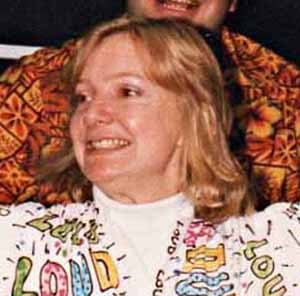 Julia Sabbagh in a 1985 photo probably by Albert DeGuzman
Julia Sabbagh in a 1985 photo probably by Albert DeGuzman
Boards 3 and 4 were often taken by designers or production artists working directly for Joe Orlando’s special projects department. Julia Sabbagh was one of those who lasted a long time at board #4, eventually moving to an office elsewhere.
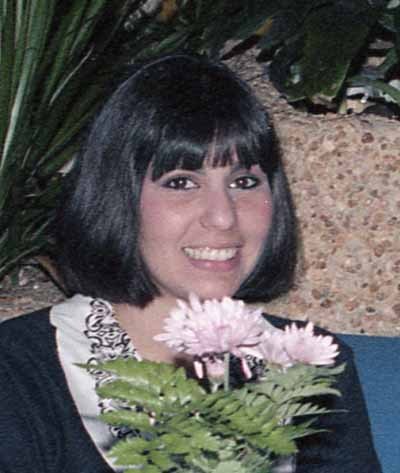 Kathy Edwards, photo by DeGuzman, sat at board #3 in front of me for a while, then moved to board #14. She was on staff for about three years.
Kathy Edwards, photo by DeGuzman, sat at board #3 in front of me for a while, then moved to board #14. She was on staff for about three years.
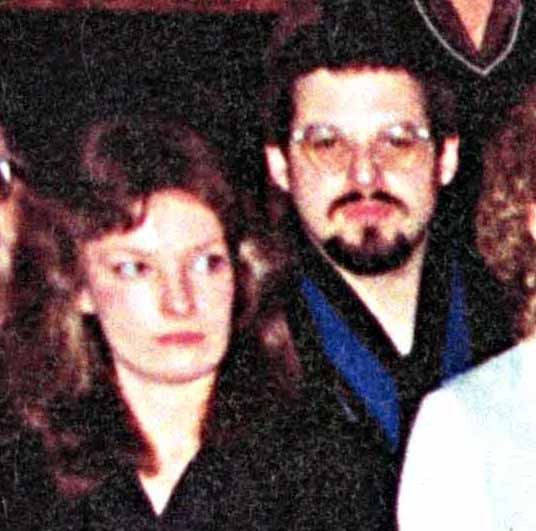 At board 8 was Nansi Hoolihan and at board 7 was Tom Ziuko, seen above in a 1982 staff photo. Both did freelance work as colorists when at home. Tom stayed with it the longest, still doing occasional color work when his health allows it.
At board 8 was Nansi Hoolihan and at board 7 was Tom Ziuko, seen above in a 1982 staff photo. Both did freelance work as colorists when at home. Tom stayed with it the longest, still doing occasional color work when his health allows it.
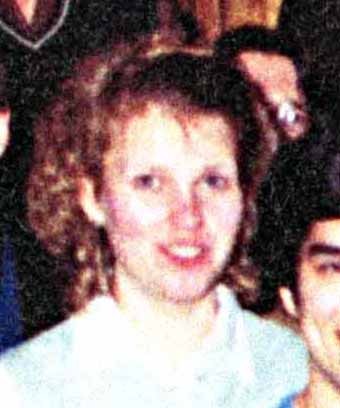 At board 9 was Helen Vesik, the other Helen, seen here in the 1982 staff photo. Helen did both lettering and coloring as a freelancer, as well as all kinds of paste-ups. In most cases, staff jobs at DC did not pay well enough to support one comfortably, so many the staff supplemented their income with freelance work of one kind or another, in a time-honored DC tradition.
At board 9 was Helen Vesik, the other Helen, seen here in the 1982 staff photo. Helen did both lettering and coloring as a freelancer, as well as all kinds of paste-ups. In most cases, staff jobs at DC did not pay well enough to support one comfortably, so many the staff supplemented their income with freelance work of one kind or another, in a time-honored DC tradition.
 At board #10 was Bob LeRose, I think the oldest person there for most of the 1980s, seen here in a photo by his friend Albert DeGuzman. Bob was a veteran of two ad agencies where he worked on custom comics for BOYS’ LIFE magazine. He joined the DC staff in 1976 and spent most of his time there assembling covers: adding the trade dress and logos, making needed art corrections and occasionally coloring them as freelance work, though most of Bob’s freelance coloring was on interior pages. Bob was the room’s curmudgeon with a heart of gold, and a father figure who we all loved, even when he was telling us to turn down the music.
At board #10 was Bob LeRose, I think the oldest person there for most of the 1980s, seen here in a photo by his friend Albert DeGuzman. Bob was a veteran of two ad agencies where he worked on custom comics for BOYS’ LIFE magazine. He joined the DC staff in 1976 and spent most of his time there assembling covers: adding the trade dress and logos, making needed art corrections and occasionally coloring them as freelance work, though most of Bob’s freelance coloring was on interior pages. Bob was the room’s curmudgeon with a heart of gold, and a father figure who we all loved, even when he was telling us to turn down the music.
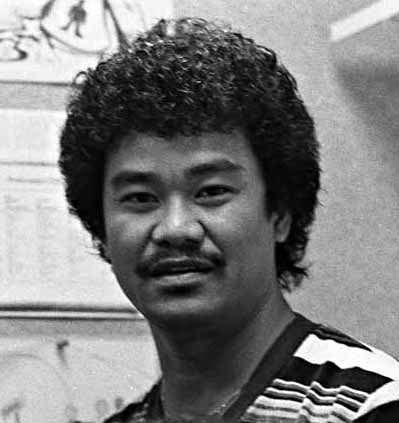 Sitting at board #11 was Albert DeGuzman, seen here in a 1983 photo he gave me. Known to all as “Albie,” he was from the Philippines and spoke English well but with a charming accent. He joined the DC staff not long after me in 1977 and spent time helping LeRose with covers and doing interior page corrections. Albie also did lots of freelance lettering at home. I’m very grateful to him for all the photos he’s provided for this article, many unseen previously. He was clearly the unofficial company photographer! Albie later moved to board #5, with it facing the front of the room, like the others. Seated later at board #11 were George Roberts (seen with receptionist Ruthie Thomas in part 1 of this article) and John Wren (photo to come).
Sitting at board #11 was Albert DeGuzman, seen here in a 1983 photo he gave me. Known to all as “Albie,” he was from the Philippines and spoke English well but with a charming accent. He joined the DC staff not long after me in 1977 and spent time helping LeRose with covers and doing interior page corrections. Albie also did lots of freelance lettering at home. I’m very grateful to him for all the photos he’s provided for this article, many unseen previously. He was clearly the unofficial company photographer! Albie later moved to board #5, with it facing the front of the room, like the others. Seated later at board #11 were George Roberts (seen with receptionist Ruthie Thomas in part 1 of this article) and John Wren (photo to come).
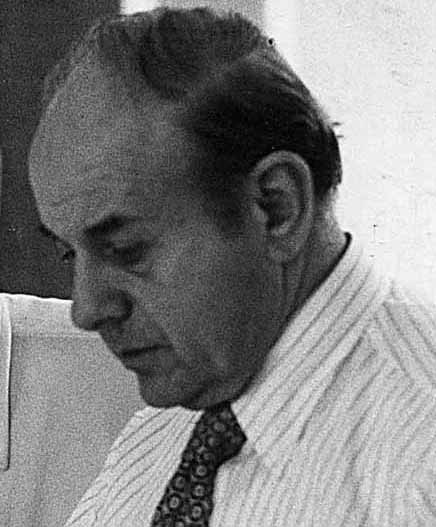 At board 12 when we moved was veteran production artist and letterer Joe Letterese, shown here in the previous offices. Joe announced his retirement soon after the move, so was not there long.
At board 12 when we moved was veteran production artist and letterer Joe Letterese, shown here in the previous offices. Joe announced his retirement soon after the move, so was not there long.
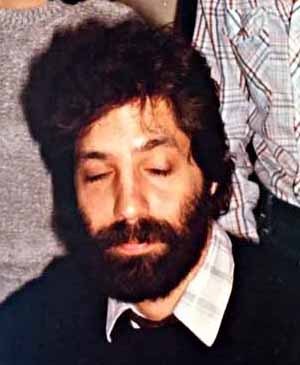 Howard Bender by George Kerrigan
Howard Bender by George Kerrigan
Replacing Joe was Howard Bender, who came from the Marvel Comics production department, and who did comics art for DC in his spare time. Howard mainly worked on covers.
 At least that’s how I remember it. Howard told me he was there for the move from 75 Rockefeller Plaza, and sent me a scan of his company photo ID card. Wish I could find mine. Howard writes: “I think I was in charge, sort of, of the record player, and every lunch we’d play classical music for Bob LeRose.” I was usually out then. The rest of the time it was often Rock records, or a rock station on the radio.
At least that’s how I remember it. Howard told me he was there for the move from 75 Rockefeller Plaza, and sent me a scan of his company photo ID card. Wish I could find mine. Howard writes: “I think I was in charge, sort of, of the record player, and every lunch we’d play classical music for Bob LeRose.” I was usually out then. The rest of the time it was often Rock records, or a rock station on the radio.
 Bob Lappan and Al Aiola by George Kerrigan.
Bob Lappan and Al Aiola by George Kerrigan.
Bob Lappan sat at board 14 when we moved in. I’m not sure who sat at board 13, or if it existed then, but it was soon filled by Al Aiola. Bob was there a few years building up his freelance lettering work, then left to do that full time. Al, a very quiet man as I recall, stayed with the company for decades. I believe he retired when the company moved to Burbank, CA in 2014-15. Both worked mostly on interior pages. Behind them you can see some of the usual clutter on the counter space: the stereo and turntable, and various machines brought over from the previous offices, most of which were used rarely if at all.
 Here’s Shelley Eiber in her Stat Room, photo by George Kerrigan, her assistant at the time. The Stat Room or darkroom was Shelley’s domain, and the rest of us were allowed to work in there only occasionally when she was busy elsewhere or out for the day. Shelly also remained with the company for decades, moving gratefully out of the darkroom when digital became the norm instead of photographic film. She retired when DC moved to Burbank in 2014-15, being at that time the longest serving staffer.
Here’s Shelley Eiber in her Stat Room, photo by George Kerrigan, her assistant at the time. The Stat Room or darkroom was Shelley’s domain, and the rest of us were allowed to work in there only occasionally when she was busy elsewhere or out for the day. Shelly also remained with the company for decades, moving gratefully out of the darkroom when digital became the norm instead of photographic film. She retired when DC moved to Burbank in 2014-15, being at that time the longest serving staffer.
 Joining the Production staff in 1983 was John Holiwski. I think he was at board #8, replacing Nansi Hoolihan when she went freelance. He may have also spent time helping Shelley Eiber in the darkroom.
Joining the Production staff in 1983 was John Holiwski. I think he was at board #8, replacing Nansi Hoolihan when she went freelance. He may have also spent time helping Shelley Eiber in the darkroom.
 I’ve skipped boards 5 and 6 because in the early years they were used by temps and freelancers mostly. Above is one summer intern at board 6 photographed by George Kerrigan, I don’t recall her name. She’s pasting together a letters column.
I’ve skipped boards 5 and 6 because in the early years they were used by temps and freelancers mostly. Above is one summer intern at board 6 photographed by George Kerrigan, I don’t recall her name. She’s pasting together a letters column.
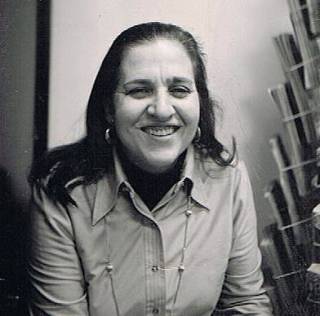 Board 5 was, I think, a smaller drawing board that moved around, sometimes it was where #16 is in the diagram and just a visitor chair was there, often filled by regular visiting freelancers like colorist Tatjana Wood, above, photo by Jack C. Harris from the 1970s. Other regulars were letterer Ben Oda, a true workaholic, who would often stay in the room working overnight, and would be found asleep at a board in the morning. Artist and part-time editor Ross Andru was another frequent guest, as was Murphy Anderson, who made regular trips to DC carrying color separations and proofs done by his company, Visual Concepts, in New Jersey. There were many others. Letterers like Gaspar Saladino and John Costanza would stop in to make corrections, and colorists such as Jerry Serpe and Carl Gafford would do the same.
Board 5 was, I think, a smaller drawing board that moved around, sometimes it was where #16 is in the diagram and just a visitor chair was there, often filled by regular visiting freelancers like colorist Tatjana Wood, above, photo by Jack C. Harris from the 1970s. Other regulars were letterer Ben Oda, a true workaholic, who would often stay in the room working overnight, and would be found asleep at a board in the morning. Artist and part-time editor Ross Andru was another frequent guest, as was Murphy Anderson, who made regular trips to DC carrying color separations and proofs done by his company, Visual Concepts, in New Jersey. There were many others. Letterers like Gaspar Saladino and John Costanza would stop in to make corrections, and colorists such as Jerry Serpe and Carl Gafford would do the same.
 Anthony “Tony” Tollin, 1983 photo by DeGuzman, who had been Assistant Production Manager before me, left staff for full-time freelance coloring before we moved to 666, but visited often to drop off work and meet with editors, as did his wife Adrienne Roy, another fine colorist. In the days before digital delivery, and when Fedex was just getting started, most freelancers lived close enough to the DC offices to visit regularly and drop off their work in person, and many spent time in the Production department, either just visiting, or doing last minute work and corrections. Artists also had legitimate reasons to stop by Production: to pick up the company-supplied art paper, or ask technical questions about what was needed from them to get their work to reproduce well. Not all visitors were there for such reasons, some were just curious or wanted to see friends in the room. Office security was much laxer then than today, and if you knew someone on staff, it wasn’t too hard to get in to see them, and then wander around visiting and exploring. There were also visitors brought around on tours by staffers, some famous, some just fans. As long as you didn’t interfere with work being done, Bob Rozakis and I were okay with visitors chatting with production staffers. I did much the same after I went freelance. Anyone causing too much noise or ruckus would be told to leave, of course.
Anthony “Tony” Tollin, 1983 photo by DeGuzman, who had been Assistant Production Manager before me, left staff for full-time freelance coloring before we moved to 666, but visited often to drop off work and meet with editors, as did his wife Adrienne Roy, another fine colorist. In the days before digital delivery, and when Fedex was just getting started, most freelancers lived close enough to the DC offices to visit regularly and drop off their work in person, and many spent time in the Production department, either just visiting, or doing last minute work and corrections. Artists also had legitimate reasons to stop by Production: to pick up the company-supplied art paper, or ask technical questions about what was needed from them to get their work to reproduce well. Not all visitors were there for such reasons, some were just curious or wanted to see friends in the room. Office security was much laxer then than today, and if you knew someone on staff, it wasn’t too hard to get in to see them, and then wander around visiting and exploring. There were also visitors brought around on tours by staffers, some famous, some just fans. As long as you didn’t interfere with work being done, Bob Rozakis and I were okay with visitors chatting with production staffers. I did much the same after I went freelance. Anyone causing too much noise or ruckus would be told to leave, of course.
 The production staff changed over time as people came and went. Meredith “Muffy” Greenough, the daughter of opera star Beverly Sills, occupied board 6 for several years. Photo by DeGuzman, 1986. Note the Superman necktie at upper left, that will be showing up in a later part of this article.
The production staff changed over time as people came and went. Meredith “Muffy” Greenough, the daughter of opera star Beverly Sills, occupied board 6 for several years. Photo by DeGuzman, 1986. Note the Superman necktie at upper left, that will be showing up in a later part of this article.
 When Tom Ziuko left staff for freelance work, Scott McCloud took his place at board 7 for a while. Scott was then working on the first issue of his comic series ZOT! and showing it to potential publishers. I lettered that first issue for him, with Bob Lappan doing the rest once he sold it to Eclipse Comics and left staff to work on ZOT! full time. Photo by DeGuzman, 1986. Note that you can see part of the Varityper Headline machine in the back right. (I would link to a photo of it, but can’t find the one we had online.) On the pillar behind Bob is a framed color proof or color guide for the SUPERMAN VS. MUHAMMAD ALI tabloid-size comic.
When Tom Ziuko left staff for freelance work, Scott McCloud took his place at board 7 for a while. Scott was then working on the first issue of his comic series ZOT! and showing it to potential publishers. I lettered that first issue for him, with Bob Lappan doing the rest once he sold it to Eclipse Comics and left staff to work on ZOT! full time. Photo by DeGuzman, 1986. Note that you can see part of the Varityper Headline machine in the back right. (I would link to a photo of it, but can’t find the one we had online.) On the pillar behind Bob is a framed color proof or color guide for the SUPERMAN VS. MUHAMMAD ALI tabloid-size comic.
 This photo by George Kerrigan shows Scott at board 7, with Helen Vesik in front of him. I’m behind at board 2, and Albert DeGuzman is standing in the back. We don’t know who is at board 3 on the right. Behind me on the wall are printing schedules for the entire DC line, probably about two months worth, so I could keep track of things. Unlike many of the desks, I had a phone at mine. It was red, but did not link directly to Commissioner Gordon’s office. I fielded calls for Bob Rozakis when he was out or away from his desk, mostly from editors, sometimes from printers, separators or other vendors. When I was given the job of returning old artwork to artists for a year or two, I spent a lot of time on that phone trying to locate artists that hadn’t been in touch with DC for many years. (Under Dick Giordano, old art was cleaned out of storage areas and returned to artists we could identify and find. Art that couldn’t be returned was eventually donated to a comics museum, I think the one run by Mort Walker.)
This photo by George Kerrigan shows Scott at board 7, with Helen Vesik in front of him. I’m behind at board 2, and Albert DeGuzman is standing in the back. We don’t know who is at board 3 on the right. Behind me on the wall are printing schedules for the entire DC line, probably about two months worth, so I could keep track of things. Unlike many of the desks, I had a phone at mine. It was red, but did not link directly to Commissioner Gordon’s office. I fielded calls for Bob Rozakis when he was out or away from his desk, mostly from editors, sometimes from printers, separators or other vendors. When I was given the job of returning old artwork to artists for a year or two, I spent a lot of time on that phone trying to locate artists that hadn’t been in touch with DC for many years. (Under Dick Giordano, old art was cleaned out of storage areas and returned to artists we could identify and find. Art that couldn’t be returned was eventually donated to a comics museum, I think the one run by Mort Walker.)
 Another photo from George Kerrigan of LeRose and DeGuzman clowning around at Bob’s desk. In back, behind Albie are drawers full of Letraset press-down lettering and Zip-a-Tone dot screen film, tools that again would soon be made obsolete by desktop printing. Note the posters for RONIN. Just above Bob’s head is an envelope tacked to the wall marked “Indicias,” which held the indicias for upcoming books, set in type by an outside photo-typesetting service. The same service set type for things like the letters pages. Albie is decorated with the revamped Wonder Woman logo created by Milton Glaser’s studio, one of two versions.
Another photo from George Kerrigan of LeRose and DeGuzman clowning around at Bob’s desk. In back, behind Albie are drawers full of Letraset press-down lettering and Zip-a-Tone dot screen film, tools that again would soon be made obsolete by desktop printing. Note the posters for RONIN. Just above Bob’s head is an envelope tacked to the wall marked “Indicias,” which held the indicias for upcoming books, set in type by an outside photo-typesetting service. The same service set type for things like the letters pages. Albie is decorated with the revamped Wonder Woman logo created by Milton Glaser’s studio, one of two versions.
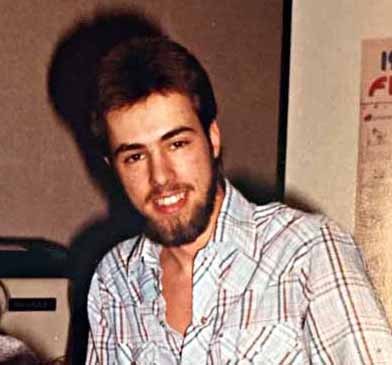 And here’s George Kerrigan from the same batch of photos, probably taken by DeGuzman. George was Shelley Eiber’s darkroom assistant at the time.
And here’s George Kerrigan from the same batch of photos, probably taken by DeGuzman. George was Shelley Eiber’s darkroom assistant at the time.
 I don’t know who this person is working at board 5 in another 1986 photo by DeGuzman, but artist Bob Smith thinks it’s artist and colorist William “Bill” Wray. Behind him left is the door to Rozakis’s office and editor Nick Cuti and myself are in the background, near the entrance to the room.
I don’t know who this person is working at board 5 in another 1986 photo by DeGuzman, but artist Bob Smith thinks it’s artist and colorist William “Bill” Wray. Behind him left is the door to Rozakis’s office and editor Nick Cuti and myself are in the background, near the entrance to the room.
 Looking up the middle row of boards from the back of the room, Mark Caraballo is in the dark shirt, I don’t know the other folks in this 1986 photo by DeGuzman, but you can get a sense of the clutter that tended to develop over time. (And the fact that I keep noticing that is an indication of why my nickname from Shelley Eiber was “Felix” as in the character from “The Odd Couple.”) Just right of the pillar is the sink area, with storage cabinets right of that.
Looking up the middle row of boards from the back of the room, Mark Caraballo is in the dark shirt, I don’t know the other folks in this 1986 photo by DeGuzman, but you can get a sense of the clutter that tended to develop over time. (And the fact that I keep noticing that is an indication of why my nickname from Shelley Eiber was “Felix” as in the character from “The Odd Couple.”) Just right of the pillar is the sink area, with storage cabinets right of that.
 We also had frequent visits from business staffers, like Peggy May, above, in another 1986 DeGuzman photo. Peggy is now married to artist Jerry Ordway. She was in the Marketing department. Behind her you can see some of the right or south wall of Production and the boards next to it. The calendar in this photo allowed me to identify the year of this batch of photos.
We also had frequent visits from business staffers, like Peggy May, above, in another 1986 DeGuzman photo. Peggy is now married to artist Jerry Ordway. She was in the Marketing department. Behind her you can see some of the right or south wall of Production and the boards next to it. The calendar in this photo allowed me to identify the year of this batch of photos.
 Here’s one of those same unidentified fellows in the northwest corner of the room, who Mark Evanier believes is artist Richard Howell. Behind him is the area that became the Assistant Production Manager’s office later. I don’t know where that plastic Viking helmet at upper right came from, but John Holiwski liked to wear it.
Here’s one of those same unidentified fellows in the northwest corner of the room, who Mark Evanier believes is artist Richard Howell. Behind him is the area that became the Assistant Production Manager’s office later. I don’t know where that plastic Viking helmet at upper right came from, but John Holiwski liked to wear it.
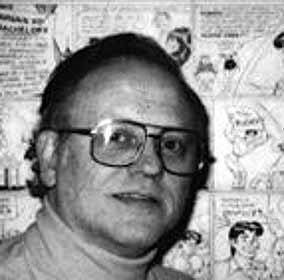 Letterer John Workman, photo found online, who took that job and office in 1988-89, board #16 in the floor plan, said of his tiny office, “My studio at home was at least eight times the size of this with two windows and a view of squirrels and trees. What was I doing here?” Makes me glad I sat out in the room with everyone when I was there! We had a lot of laughs while getting a ton of work done.
Letterer John Workman, photo found online, who took that job and office in 1988-89, board #16 in the floor plan, said of his tiny office, “My studio at home was at least eight times the size of this with two windows and a view of squirrels and trees. What was I doing here?” Makes me glad I sat out in the room with everyone when I was there! We had a lot of laughs while getting a ton of work done.
Next time I’ll continue with more editorial staff pictures and stories from later in the 1980s. Other parts of this article, and more you might enjoy, can be found on the COMICS CREATION page of my blog.
August 2, 2016
THE DC COMICS OFFICES 1982-1991 Part 2
 Continuing with the DC staff when the offices at 666 5th Avenue were first opened in December, 1982 and soon after, here’s my floor plan from that time, drawing on the memories of other staffers. It may well be wrong in some details, but is reasonably close in general.
Continuing with the DC staff when the offices at 666 5th Avenue were first opened in December, 1982 and soon after, here’s my floor plan from that time, drawing on the memories of other staffers. It may well be wrong in some details, but is reasonably close in general.
 Here’s a closer look at the right half of the plan, which I’ll be covering next, moving right on the main hallway at the top.
Here’s a closer look at the right half of the plan, which I’ll be covering next, moving right on the main hallway at the top.
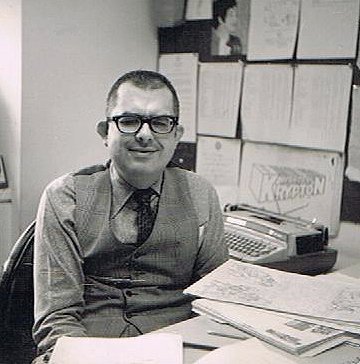 We don’t recall where long-time editor E. Nelson Bridwell sat when these offices opened, so I’ve put him in the first small office on the right of the main hall. This photo, found online, is probably from his office at 75 Rockefeller Plaza, and from the late 1970s. I designed the WORLD OF KRYPTON logo on his wall for the 1978 series. Nelson was a character, full of odd personality quirks, but a fount of knowledge on early DC comics and character histories. It’s possible Nelson may have already had an office in the area marked “New construction later,” the only place we remember him sitting. I don’t know when those offices were built, some may have already been there when we moved in.
We don’t recall where long-time editor E. Nelson Bridwell sat when these offices opened, so I’ve put him in the first small office on the right of the main hall. This photo, found online, is probably from his office at 75 Rockefeller Plaza, and from the late 1970s. I designed the WORLD OF KRYPTON logo on his wall for the 1978 series. Nelson was a character, full of odd personality quirks, but a fount of knowledge on early DC comics and character histories. It’s possible Nelson may have already had an office in the area marked “New construction later,” the only place we remember him sitting. I don’t know when those offices were built, some may have already been there when we moved in.
 Mary (Moebus) Yedlin, Licensing Coordinator, in a photo by Albert DeGuzman, had the window office on the left side of the hall opposite.
Mary (Moebus) Yedlin, Licensing Coordinator, in a photo by Albert DeGuzman, had the window office on the left side of the hall opposite.
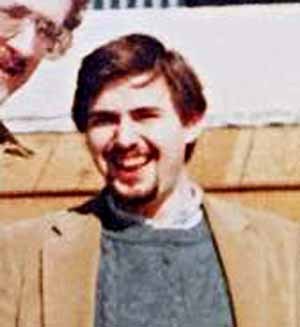
Seen here in a 1985 photo by DeGuzman, Promotion Manager Mike Flynn, like many staffers, reports he worked in several offices at 666 5th Avenue. He told me: “I don’t remember why I was moved three times in barely a year. I think it had to do with trying to keep the editorial and non-editorial departments together.” Mike says he was where I show him first, then near the entrance (where I have the Film Library, which would be after it moved), then where I have Neal Pozner. (That last placement conflicts with my own memory of Neal always being right opposite Production, so you can see the problem with conflicting memories.) Mike also wrote:
“For a good chunk of my time at 666 Fifth Avenue, my office was right next to Julie Schwartz’s. Every day I’d walk past his office—he was always in before I was—and I’d say, ‘Good morning, Julie!’ Without looking up from whatever he was reading, he’d say gruffly, ‘Prove it!’ And nothing else. I liked that.”
 Julius Schwartz by Albert DeGuzman, 1985.
Julius Schwartz by Albert DeGuzman, 1985.
 SUPERMAN #411 cover © DC Comics.
SUPERMAN #411 cover © DC Comics.
I don’t have a photo of Senior Editor Julius “Julie” Schwartz in his office, but we do have this illustration of it by Dick Giordano from a special birthday tribute that was produced by the DC staff without Julie’s knowledge for his 70th birthday in 1985. Julie began working for All-American Comics in 1944, and when that company was combined with what is now DC, became an important editor credited with helping revive DC’s superheroes in the late 1950s, and initiating what’s now known as comics’ “Silver Age.” Julie’s office was also a great place to meet his science fiction writer friends like Ray Bradbury, Frederick Pohl and Harlan Ellison when they came to visit.
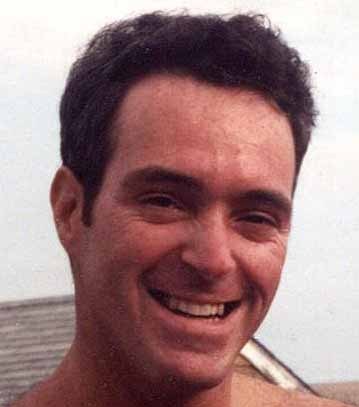 In the next window office was Neal Pozner, seen here in a photo by Phil Jimenez. Neal was DC’s first Design Director. Vince Colletta had the title Art Director previously, but did very little actual art directing from what I could tell. Neal was a comics fan, and had experience as a freelance designer before joining DC around 1980, I believe. He brought new design concepts and perfectionism to the job, and made great improvements to the overall look of DC’s covers and product in general.
In the next window office was Neal Pozner, seen here in a photo by Phil Jimenez. Neal was DC’s first Design Director. Vince Colletta had the title Art Director previously, but did very little actual art directing from what I could tell. Neal was a comics fan, and had experience as a freelance designer before joining DC around 1980, I believe. He brought new design concepts and perfectionism to the job, and made great improvements to the overall look of DC’s covers and product in general.
 Judy Fireman, seen here in a photo by DeGuzman, held the next small office for a brief time. According to Bob Greenberger, she had been hired by Jenette Kahn to sell books based on the DC library. Her one major sale was the “Super-Hero Super-Healthy Cookbook.”
Judy Fireman, seen here in a photo by DeGuzman, held the next small office for a brief time. According to Bob Greenberger, she had been hired by Jenette Kahn to sell books based on the DC library. Her one major sale was the “Super-Hero Super-Healthy Cookbook.”
 Tom Condon had that office next beginning some time in 1983. He handled contracts, and was brought in by Paul Levitz to help bring more business experience to the Editorial Department. Photo by DeGuzman.
Tom Condon had that office next beginning some time in 1983. He handled contracts, and was brought in by Paul Levitz to help bring more business experience to the Editorial Department. Photo by DeGuzman.
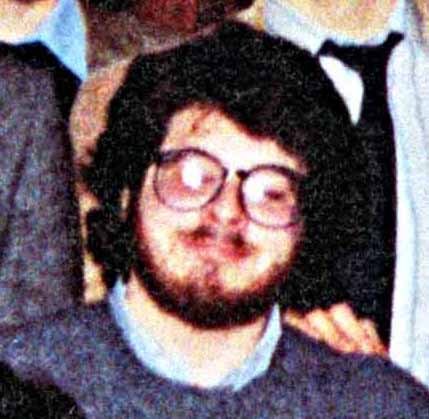 Where the main hall divided was a group of offices for Joe Orlando’s Special Projects division. Andrew “Andy” Helfer was in an office there. He had been hired in May, 1980 to work part-time on Wonder Woman’s 40th Anniversary, then moved to Special Projects full time in Sept. 1980.
Where the main hall divided was a group of offices for Joe Orlando’s Special Projects division. Andrew “Andy” Helfer was in an office there. He had been hired in May, 1980 to work part-time on Wonder Woman’s 40th Anniversary, then moved to Special Projects full time in Sept. 1980.
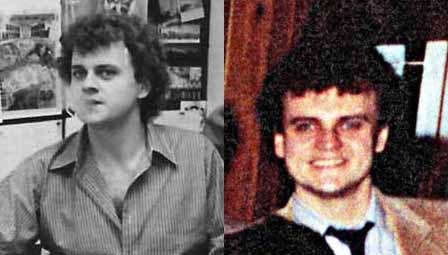 His office was shared with Dave Manak. Dave had been a comics editor at 75 Rockefeller Plaza, the previous offices, but I believe switched over to working for Special Projects with the move to 666. Helfer went on to become a comics editor as well, and Dave moved on from DC a year or two later, returning to freelance work. For Orlando, both worked on comics for licensed properties like MASTERS OF THE UNIVERSE, custom comics for other companies, and other non-mainstream comics licensing projects. The black and white photo of Dave in his 75 Rock office was supplied by Howard Bender, the color images are from a 1982 staff photo I wrote about HERE.
His office was shared with Dave Manak. Dave had been a comics editor at 75 Rockefeller Plaza, the previous offices, but I believe switched over to working for Special Projects with the move to 666. Helfer went on to become a comics editor as well, and Dave moved on from DC a year or two later, returning to freelance work. For Orlando, both worked on comics for licensed properties like MASTERS OF THE UNIVERSE, custom comics for other companies, and other non-mainstream comics licensing projects. The black and white photo of Dave in his 75 Rock office was supplied by Howard Bender, the color images are from a 1982 staff photo I wrote about HERE.
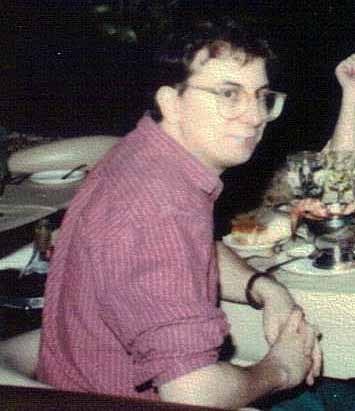 Joey Cavalieri by Bob Rozakis, 1985.
Joey Cavalieri by Bob Rozakis, 1985.
Another staffer working under Joe Orlando was Joey Cavalieri. I think he was already writing for DC when he joined the staff, probably around the time of the move to 666. I’m not sure where he sat, he may have shared the office with Helfer and Manak. Like Helfer, Joey later moved to Editorial and had two stints as an editor there for DC, with time at Marvel between.
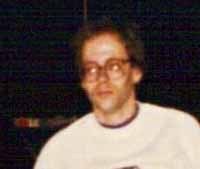 Barry Marx also worked on special projects under Joe Orlando beginning in 1984, seen here in a 1985 photo by DeGuzman. I don’t know where he sat. He may have replaced Dave Manak. Another Special Projects staffer in the early days of 666 was Connie Hatch.
Barry Marx also worked on special projects under Joe Orlando beginning in 1984, seen here in a 1985 photo by DeGuzman. I don’t know where he sat. He may have replaced Dave Manak. Another Special Projects staffer in the early days of 666 was Connie Hatch.
 Turning left one came to the office of Joe Orlando, seen here in an undated photo with Brooke Shields by Albert DeGuzman. Joe had one of the larger window offices accessed through the office of his assistant, Lucia Gorpfert. Joe had begun his comics career in the early 1950s as an artist for companies like EC, and had joined DC as an editor in 1968 where he brought new life to the company’s weird/mystery titles like HOUSE OF MYSTERY, and launched SWAMP THING. I’m not sure when he made the transition to Vice President in charge of Special Projects, but that was his role at the 666 offices. Joe also oversaw the Production Department.
Turning left one came to the office of Joe Orlando, seen here in an undated photo with Brooke Shields by Albert DeGuzman. Joe had one of the larger window offices accessed through the office of his assistant, Lucia Gorpfert. Joe had begun his comics career in the early 1950s as an artist for companies like EC, and had joined DC as an editor in 1968 where he brought new life to the company’s weird/mystery titles like HOUSE OF MYSTERY, and launched SWAMP THING. I’m not sure when he made the transition to Vice President in charge of Special Projects, but that was his role at the 666 offices. Joe also oversaw the Production Department.
 Here’s Terri Cunningham with Joe Orlando’s assistant Lucia (Viera) Gorpfert in a 1985 photo by DeGuzman. I’m not sure when Terri joined Joe Orlando’s Special Projects team, but when she did, she sat in the next office down the hall. She’s seen here in a 1984 photo by DeGuzman. Terri was the project manager, I think. She later moved over to Editorial, becoming the Manager of Editorial Administration, another of those thankless jobs trying to keep everything on schedule. When she did that, Angelina Genduso moved from the business side to take her place and office.
Here’s Terri Cunningham with Joe Orlando’s assistant Lucia (Viera) Gorpfert in a 1985 photo by DeGuzman. I’m not sure when Terri joined Joe Orlando’s Special Projects team, but when she did, she sat in the next office down the hall. She’s seen here in a 1984 photo by DeGuzman. Terri was the project manager, I think. She later moved over to Editorial, becoming the Manager of Editorial Administration, another of those thankless jobs trying to keep everything on schedule. When she did that, Angelina Genduso moved from the business side to take her place and office.
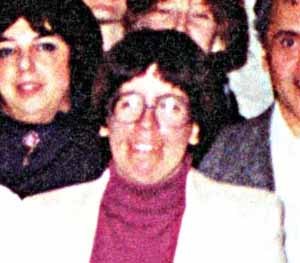 Next to Terry was the Proofreader’s office, I believe originally held by Tamsyn O’Flynn, seen above in the 1982 staff photo. Other Editorial proofreaders were Robert Loren Fleming, soon a writer of the DC series THRILLER, and Brenda Pope. Later the proofreading job moved from Editorial to the Production Department, though in a separate office, and was held by Liz Flynn, Gary Race, and then Arlene Lo for decades.
Next to Terry was the Proofreader’s office, I believe originally held by Tamsyn O’Flynn, seen above in the 1982 staff photo. Other Editorial proofreaders were Robert Loren Fleming, soon a writer of the DC series THRILLER, and Brenda Pope. Later the proofreading job moved from Editorial to the Production Department, though in a separate office, and was held by Liz Flynn, Gary Race, and then Arlene Lo for decades.
 Vice President – Executive Editor Dick Giordano had the other large window office, seen here in an undated photo found online. Dick had a long career as an editor beginning with Charlton Comics in the 1960s, as well as a reputation as one of the best inkers in comics. He had a first stint as editor at DC in the late 1960s to early 1970s, and returned as Executive Editor in 1981. Dick continued to ink comics for the company, mostly covers, while at 666 as well as overseeing the Editorial side.
Vice President – Executive Editor Dick Giordano had the other large window office, seen here in an undated photo found online. Dick had a long career as an editor beginning with Charlton Comics in the 1960s, as well as a reputation as one of the best inkers in comics. He had a first stint as editor at DC in the late 1960s to early 1970s, and returned as Executive Editor in 1981. Dick continued to ink comics for the company, mostly covers, while at 666 as well as overseeing the Editorial side.
 Dick’s assistant was Pat Bastienne, seen here in a photo by Albert DeGuzman. Pat worked closely with Dick on art assignments for DC’s comics. Both Pat and Dick knew most of the artists in the business, and also made time to talk to new talent trying to break in.
Dick’s assistant was Pat Bastienne, seen here in a photo by Albert DeGuzman. Pat worked closely with Dick on art assignments for DC’s comics. Both Pat and Dick knew most of the artists in the business, and also made time to talk to new talent trying to break in.
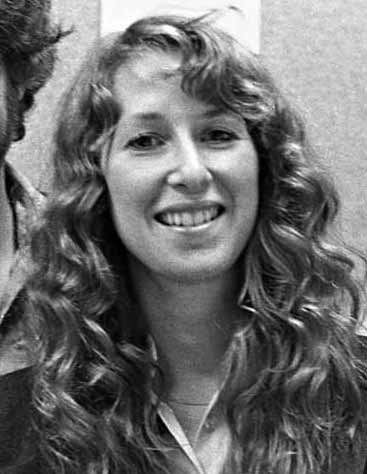 In the small office behind Pat Bastienne sat Karen Berger, seen here in a 1983 photo by DeGuzman. Karen handled lettering and coloring assignments originally, as well as editing some comics. Karen soon moved to a different office when that scheduling job was taken over by Pat Bastienne, becoming a full-time editor.
In the small office behind Pat Bastienne sat Karen Berger, seen here in a 1983 photo by DeGuzman. Karen handled lettering and coloring assignments originally, as well as editing some comics. Karen soon moved to a different office when that scheduling job was taken over by Pat Bastienne, becoming a full-time editor.
 When Pat moved into that back office previously occupied by Karen, Alyce (Schuller) Raeford was hired to be the new secretary/assistant for both she and Dick Giordano, taking the front office where Pat had been. Photo by Bob Rozakis from 1985.
When Pat moved into that back office previously occupied by Karen, Alyce (Schuller) Raeford was hired to be the new secretary/assistant for both she and Dick Giordano, taking the front office where Pat had been. Photo by Bob Rozakis from 1985.
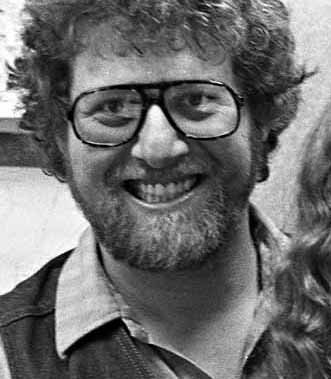 In the last window office, by the window, was editor Len Wein, seen here in a 1983 photo by DeGuzman. Len began writing comics for DC in 1968, and notably co-created SWAMP THING with Bernie Wrightson in 1971. He also wrote for Marvel Comics, and was an editor there in the mid 1970s. In 1978 he returned to DC as both a writer and editor through most of the 1980s.
In the last window office, by the window, was editor Len Wein, seen here in a 1983 photo by DeGuzman. Len began writing comics for DC in 1968, and notably co-created SWAMP THING with Bernie Wrightson in 1971. He also wrote for Marvel Comics, and was an editor there in the mid 1970s. In 1978 he returned to DC as both a writer and editor through most of the 1980s.
 Sharing Len’s office, and working on some titles as his assistant when 666 opened was Nicola “Nick” Cuti, seen here in a 1985 photo by DeGuzman. Nick had a long career as writer and editor, first for Charlton, then for Warren before joining DC, where he also wrote comics like SPANNER’S GALAXY. Nick later moved into the room next door with Wolfman and Colón.
Sharing Len’s office, and working on some titles as his assistant when 666 opened was Nicola “Nick” Cuti, seen here in a 1985 photo by DeGuzman. Nick had a long career as writer and editor, first for Charlton, then for Warren before joining DC, where he also wrote comics like SPANNER’S GALAXY. Nick later moved into the room next door with Wolfman and Colón.
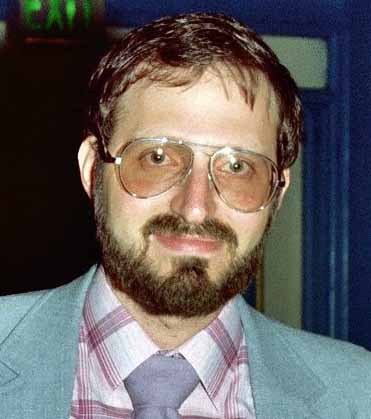 Marv Wolfman, 1982, photo by Alan Light.
Marv Wolfman, 1982, photo by Alan Light.
The last office on the right end of the floor plan held three desks, and had probably the most shifts of personnel in the company, with editors moving in and out all the time, or sharing the space. Originally the first desk was for part-time editors or writer-editors like Marv Wolfman, above. Marv came into the office regularly, but not every day. Like his friend Len Wein, he’d also been an editor and writer for Marvel Comics in the 1970s after early writing sales to DC, and at 666 edited several titles, including some he wrote.
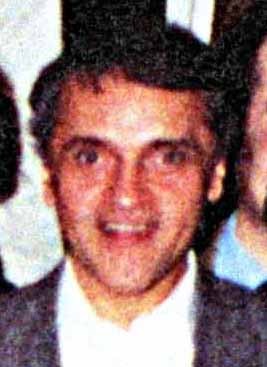 The back desk in that office was originally held by Ernie Colón. Ernie joined DC as a Junior Editor in the spring of 1982, working with Marv, and by the time of the move to 666 was solo editing several titles for the company. He left staff around the end of 1983 for full-time freelance work, and was the regular artist on AMETHYST, PRINCESS OF GEMWORLD among other titles.
The back desk in that office was originally held by Ernie Colón. Ernie joined DC as a Junior Editor in the spring of 1982, working with Marv, and by the time of the move to 666 was solo editing several titles for the company. He left staff around the end of 1983 for full-time freelance work, and was the regular artist on AMETHYST, PRINCESS OF GEMWORLD among other titles.
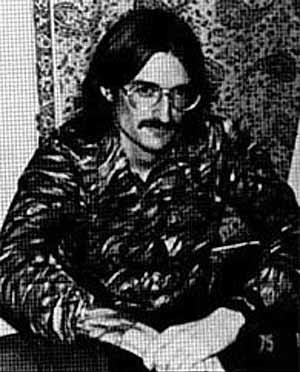 Roger Slifer, date and source unknown.
Roger Slifer, date and source unknown.
Not long before the move from 75 Rockefeller Plaza, Roger Slifer was hired to be DC’s first Direct Sales Manager, and shared a cramped office with Mike Flynn and Bruce Bristow. Roger had been writing and editing at Marvel, and was probably recommended by his friends Len Wein and Marv Wolfman. He was a funny guy. One time, passing in the hall, I asked him, “What’s new, Roger?” He replied, “Brain’s full of old stuff, no room for new stuff.” Roger switched to the Editorial Department around the time of the move to 666 and worked in the shared office with Wolfman and Colón. He edited books like WORLD’S FINEST, with his first editor credit appearing on the May, 1983 issue. He also wrote THE OMEGA MEN for DC, a title I later took over as writer myself. I believe Roger left DC around May of 1984 for full-time freelance work.
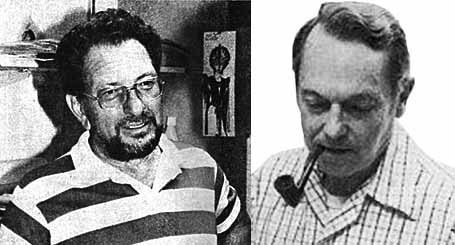 Other editors who only came into the offices one or two days a week, like Joe Kubert and Murray Boltinoff, above, probably used the first or middle desks or sat wherever there was an empty space.
Other editors who only came into the offices one or two days a week, like Joe Kubert and Murray Boltinoff, above, probably used the first or middle desks or sat wherever there was an empty space.
 Roy Thomas, 1977 and Gerry Conway, undated
Roy Thomas, 1977 and Gerry Conway, undated
A few writer-editors like Roy Thomas and Gerry Conway lived far away and seldom visited DC, so didn’t need office space.
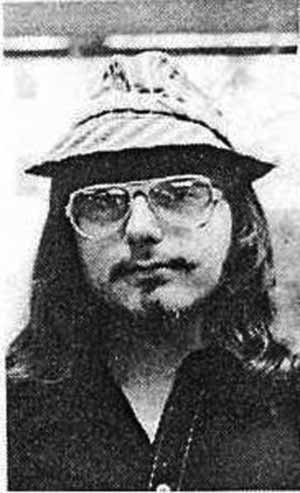 Carl Gafford, date and source unknown.
Carl Gafford, date and source unknown.
Carl Gafford, a colorist for DC, also did some editing from about April 1982 to early 1983. Bob Greenberger remembers him sitting in Len Wein’s office working as his assistant for a short time, Perhaps before Nick Cuti took that position.
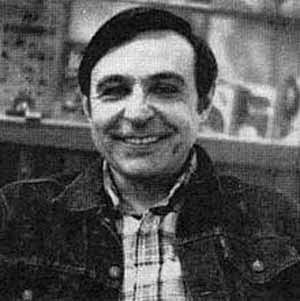 Ross Andru, 1977, source unknown.
Ross Andru, 1977, source unknown.
A prolific artist for DC, Ross Andru also edited several titles for the company beginning in 1979, and continuing until 1986. He may have used this office, though I mostly remember him sitting in the Production room when he came in.
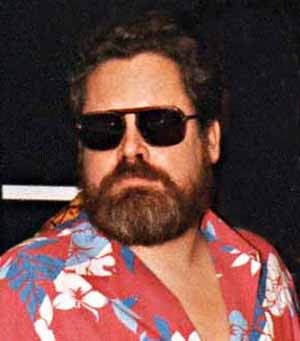 Artist Ed Hannigan, shown here in a photo probably by Albert DeGuzman from 1985, began doing cover art for DC around the time of the move to 666, He did more and more as time went by, and then began doing cover designs/layouts for other artists as well. At some point he was given a staff job as Cover Designer with office space in the New Construction area. I’m not sure where he sat.
Artist Ed Hannigan, shown here in a photo probably by Albert DeGuzman from 1985, began doing cover art for DC around the time of the move to 666, He did more and more as time went by, and then began doing cover designs/layouts for other artists as well. At some point he was given a staff job as Cover Designer with office space in the New Construction area. I’m not sure where he sat.
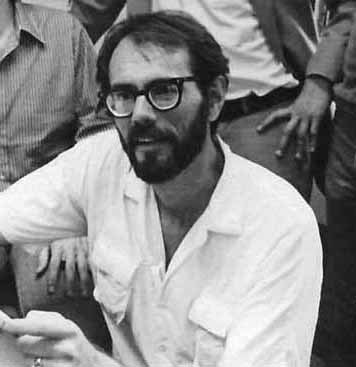 There are a few others I believe were on staff in the early days of DC at 666 5th Avenue that I can’t place in an office, like Robin Snyder, another assistant to Dick Giordano, as well as editors Dave Manak and Cary Burkett (at 75 Rock), seen here in a 1981 photo supplied by Howard Bender. There’s only so much we can remember about those days nearly 35 years ago!
There are a few others I believe were on staff in the early days of DC at 666 5th Avenue that I can’t place in an office, like Robin Snyder, another assistant to Dick Giordano, as well as editors Dave Manak and Cary Burkett (at 75 Rock), seen here in a 1981 photo supplied by Howard Bender. There’s only so much we can remember about those days nearly 35 years ago!
To clarify the editorial staff assignments, I went through all the books cover-dated March 1983. Those would have been worked on mostly in November and December of 1982, when the offices at 666 5th Avenue opened. Here’s a rundown of editors and their books, as credited on the Grand Comics Database and the DC Wikia.
JULIUS SCHWARTZ: Action Comics, DC Comics Presents, The New Adventures of Superboy, Supergirl and Superman
JULIUS SCHWARTZ assisted by E. NELSON BRIDWELL: Weird War Tales (Nelson probably assisted on other Schwartz books too)
LEN WEIN: Camelot 3000, The New Teen Titans, Saga of the Swamp Thing
LEN WEIN assisted by NICOLA CUTI: All-Star Squadron, Batman, The Brave and the Bold, Detective Comics, Justice League of America.
ERNIE COLÓN: Arion Lord of Atlantis, The Flash, Green Lantern
MARV WOLFMAN: Blackhawk, Night Force, Wonder Woman, World’s Finest.
KAREN BERGER: House of Mystery, Legion of Super-Heroes
CARL GAFFORD: Adventure Comics
ROY THOMAS: Arak Son of Thunder, Captain Carrot and his Amazing Zoo Crew
GERRY CONWAY: The Fury of Firestorm
MURRAY BOLTINOFF: G.I. Combat
ROSS ANDRU: Jonah Hex, The Warlord
JOE KUBERT: Sgt. Rock
BOB ROZAKIS, NICOLA CUTI AND CARL GAFFORD: The Best of DC (digest size)
Note that other titles not published that month are not included here.
We’ll continue next time with the Production Department, the area I remember best, as I worked there. Other parts of this article and more you might enjoy can be found on the COMICS CREATION page of my blog.
August 1, 2016
THE DC COMICS OFFICES 1982-1991 Part 1
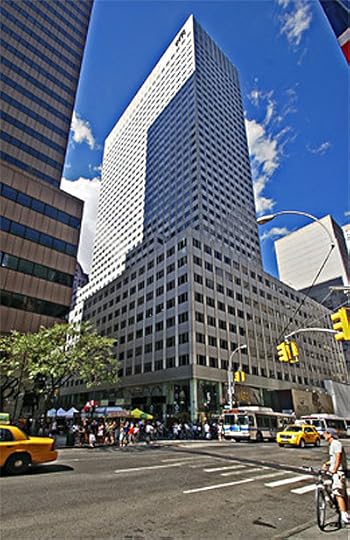 In the late 1970s, the staff of DC Comics had shrunk due to cutbacks nicknamed “The DC Implosion,” but by 1982 the staff was growing again and a move was planned from 75 Rockefeller Plaza to a new location across 52nd Street, the Tishman Building.
In the late 1970s, the staff of DC Comics had shrunk due to cutbacks nicknamed “The DC Implosion,” but by 1982 the staff was growing again and a move was planned from 75 Rockefeller Plaza to a new location across 52nd Street, the Tishman Building.
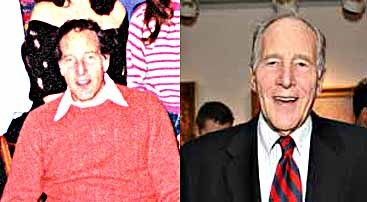 William Sarnoff from a 1982 DC Comics staff photo and 2005.
William Sarnoff from a 1982 DC Comics staff photo and 2005.
DC was then in the Warner Publishing Services division of Warner Communications, directed by William Sarnoff, and all of Warner Publishing moved, with DC mostly on the 8th floor of the Tishman Building. On the 9th floor were Warner Books, the magazine distribution division, and Publishers Advertising Association (which handled publicity for Warner Books Authors), as well as DC’s accounting department and mailroom, all overseen by Sarnoff as Chairman of Warner Publishing Services.
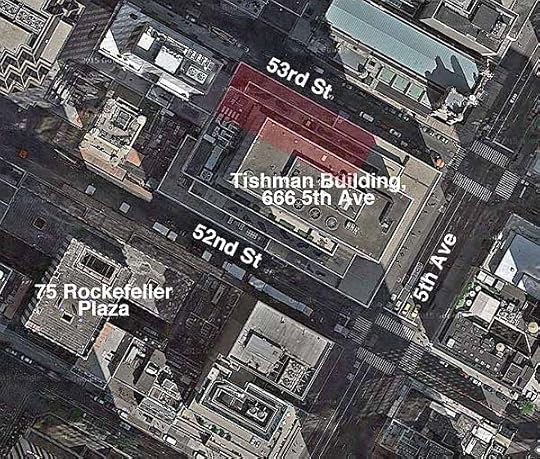 A satellite view from Google Maps showing the approximate location of the DC offices tinted red. On the other side of 53rd was the St. Thomas Episcopal Church and the Museum of Modern Art. As an employee of DC since 1977, I was already familiar with some parts of the Tishman building because the E and F subway train station was below it, so when I commuted to work on the E train from Penn Station, I would emerge there and walk across 52nd Street to the DC offices at 75 Rockefeller Plaza. There was a large two-floor B. Dalton bookstore at street level, on the southeast corner of the Tishman building that I frequented, and on the basement level a restaurant, “Pastrami & Things” that became a favorite of DC staffers once we moved in, though we could still eat at the Warner cafeteria under 75 Rock as well, and I often lunched elsewhere nearby.
A satellite view from Google Maps showing the approximate location of the DC offices tinted red. On the other side of 53rd was the St. Thomas Episcopal Church and the Museum of Modern Art. As an employee of DC since 1977, I was already familiar with some parts of the Tishman building because the E and F subway train station was below it, so when I commuted to work on the E train from Penn Station, I would emerge there and walk across 52nd Street to the DC offices at 75 Rockefeller Plaza. There was a large two-floor B. Dalton bookstore at street level, on the southeast corner of the Tishman building that I frequented, and on the basement level a restaurant, “Pastrami & Things” that became a favorite of DC staffers once we moved in, though we could still eat at the Warner cafeteria under 75 Rock as well, and I often lunched elsewhere nearby.
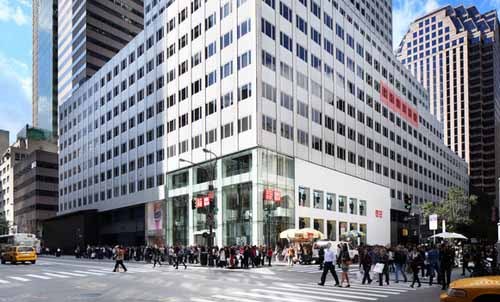 This is the best photo I could find of the 53rd Street side of the building. I believe the DC offices were where I’ve tinted red, but more window offices are hidden by a setback in the facade.
This is the best photo I could find of the 53rd Street side of the building. I believe the DC offices were where I’ve tinted red, but more window offices are hidden by a setback in the facade.
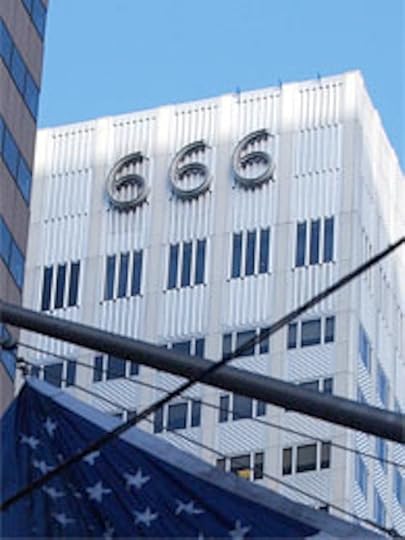 Though it’s been replaced by another sign, the large 666 atop the Tishman Building was a landmark for decades, and jokes about “the number of the beast” were frequent. In Neil Gaiman and Terry Pratchett’s novel “Good Omens,” it’s the headquarters of Famine. An expensive restaurant on the highest floor was known as “Top of the Sixes.” The Tishman Building, constructed in 1957, was 41 stories high and held 1.5 million square feet of office space. It was designed by Carson & Lundin and built by the well-known Tishman Realty & Construction Company begun by Julius Tishman in 1898 and run by his family.
Though it’s been replaced by another sign, the large 666 atop the Tishman Building was a landmark for decades, and jokes about “the number of the beast” were frequent. In Neil Gaiman and Terry Pratchett’s novel “Good Omens,” it’s the headquarters of Famine. An expensive restaurant on the highest floor was known as “Top of the Sixes.” The Tishman Building, constructed in 1957, was 41 stories high and held 1.5 million square feet of office space. It was designed by Carson & Lundin and built by the well-known Tishman Realty & Construction Company begun by Julius Tishman in 1898 and run by his family.
Perhaps the most unusual reference to the building is in this song about Tishman by singer/comedian Allan Sherman on his 1967 album “Togetherness.” Listen for references to the elevators and rest rooms. Sherman was with Warner Music, so perhaps he spent time in the building on business. Note the song says there are 48 stories instead of 41 as reported by Wikipedia.
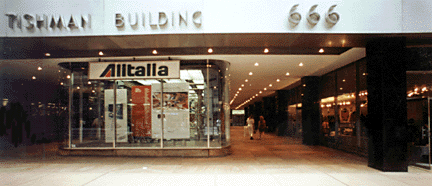 The ground floor had a T-shaped open corridor that connected 52nd to 53rd street, and from the center went to 5th Avenue, as shown here. The B. Dalton bookstore was just to the left, out of this picture, and the actual entrance to the building was at the end of the corridor. This arm of the corridor has since been filled with stores.
The ground floor had a T-shaped open corridor that connected 52nd to 53rd street, and from the center went to 5th Avenue, as shown here. The B. Dalton bookstore was just to the left, out of this picture, and the actual entrance to the building was at the end of the corridor. This arm of the corridor has since been filled with stores.
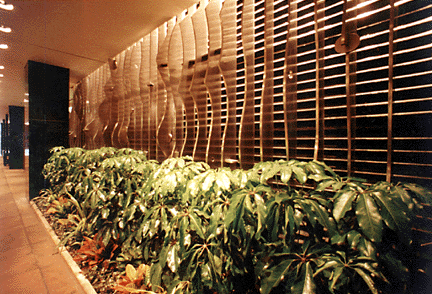 The corridor running from 52nd to 53rd was fronted by an Isamu Noguchi sculpture and plants. The stairs down to the subway were just right of this picture, and the building entrance was between the black pillars further down.
The corridor running from 52nd to 53rd was fronted by an Isamu Noguchi sculpture and plants. The stairs down to the subway were just right of this picture, and the building entrance was between the black pillars further down.
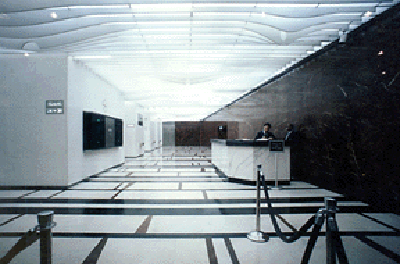 Looking into the elevator lobby with more Noguchi sculptures on the ceiling. Elevators to different groups of floors were in halls down and to the left.
Looking into the elevator lobby with more Noguchi sculptures on the ceiling. Elevators to different groups of floors were in halls down and to the left.
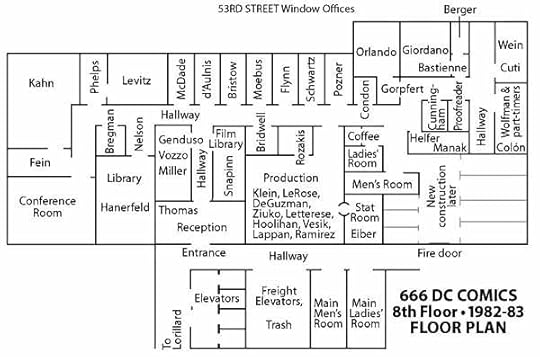 Here’s a floor plan of the DC offices when we moved in and soon after, drawn up by me with lots of consultation and input from other staffers at the time, including Bob Rozakis and Paul Levitz. It’s based on our collective memories, not any actual plans, and may well be off in proportions and seating details, but it’s reasonably close. Paul remembers the move was largely handled by Office Manager Midge Bregman under his direction. Working with Midge was a new employee, Angelina Genduso, who also helped with the move, which I believe happened in the last week of November, 1982. The new offices were officially open for business the first week of December. Bob Rozakis remembers, “Because of the locations of the loading docks and the directions of one-way streets, the trucks had to load and drive about six blocks from one building to the other. They spent more time in traffic than anything else.”
Here’s a floor plan of the DC offices when we moved in and soon after, drawn up by me with lots of consultation and input from other staffers at the time, including Bob Rozakis and Paul Levitz. It’s based on our collective memories, not any actual plans, and may well be off in proportions and seating details, but it’s reasonably close. Paul remembers the move was largely handled by Office Manager Midge Bregman under his direction. Working with Midge was a new employee, Angelina Genduso, who also helped with the move, which I believe happened in the last week of November, 1982. The new offices were officially open for business the first week of December. Bob Rozakis remembers, “Because of the locations of the loading docks and the directions of one-way streets, the trucks had to load and drive about six blocks from one building to the other. They spent more time in traffic than anything else.”
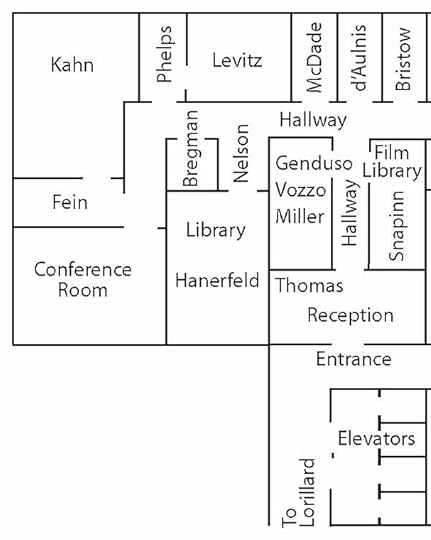 Looking more closely at the left side of the floor plan, as you emerged from the elevators, you turned right to the DC Comics entrance door. The other way led to the offices of the Lorillard Tobacco Company which held most or all of the remaining 8th floor.
Looking more closely at the left side of the floor plan, as you emerged from the elevators, you turned right to the DC Comics entrance door. The other way led to the offices of the Lorillard Tobacco Company which held most or all of the remaining 8th floor.
The entrance door had a small round porthole window with the DC symbol etched on the glass, as seen above, and inside, by one of the visitor waiting couches, was a statue of Clark Kent reading a newspaper. The sculpture was created for these offices, I don’t know the sculptor. It was reasonably realistic, clad in real clothes, and caused many double-takes by visitors.
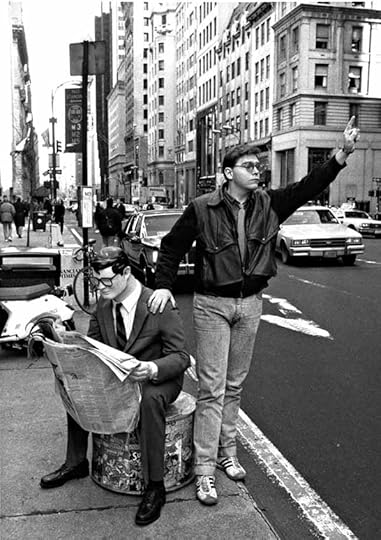 Photo courtesy of Mike Carlin.
Photo courtesy of Mike Carlin.
The statue actually sat on a connected round pedestal with DC comics covers on it. The entire thing must have been fairly light, because editor Mike Carlin was able to bring Clark to DC’s 50th anniversary party in 1988 at the Puck building. Here he is hailing a cab on 5th Avenue for himself and Clark. I can just imagine the cabby’s reaction.
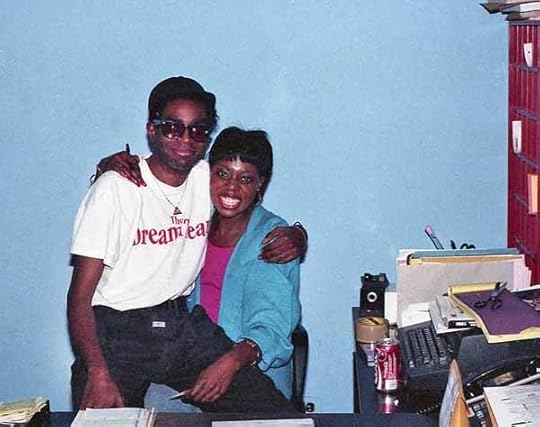 In one corner of the reception area sat Ruthie Thomas, shown here in a 1986 photo by Steven Bové with production artist George Roberts. To her right are mail cubicles where entering staff could pick up their mail and phone messages, or Ruthie would deliver them if they sat too long. We all remember Ruthie, now Ruthie Chisolm, as charming and professional. She didn’t take any nonsense from visitors! To the right of the mail slots was the actual entrance, a Dutch door with the top half almost always open.
In one corner of the reception area sat Ruthie Thomas, shown here in a 1986 photo by Steven Bové with production artist George Roberts. To her right are mail cubicles where entering staff could pick up their mail and phone messages, or Ruthie would deliver them if they sat too long. We all remember Ruthie, now Ruthie Chisolm, as charming and professional. She didn’t take any nonsense from visitors! To the right of the mail slots was the actual entrance, a Dutch door with the top half almost always open.
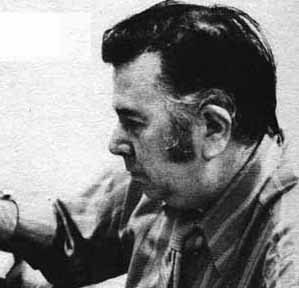 Up a short hall, there were single doors on each side. On the right was the Film Library overseen by longtime employee Milt Snapinn, above. The Film Library did not stay there long, in a year or two it had moved to elsewhere in the building, and then much further away to a location in Flushing, Queens, making room for other business offices in that area. The film involved was the printer’s film for all DC comics from when it had begun to be saved in the early 1950s. Later, it was converted to digital files.
Up a short hall, there were single doors on each side. On the right was the Film Library overseen by longtime employee Milt Snapinn, above. The Film Library did not stay there long, in a year or two it had moved to elsewhere in the building, and then much further away to a location in Flushing, Queens, making room for other business offices in that area. The film involved was the printer’s film for all DC comics from when it had begun to be saved in the early 1950s. Later, it was converted to digital files.
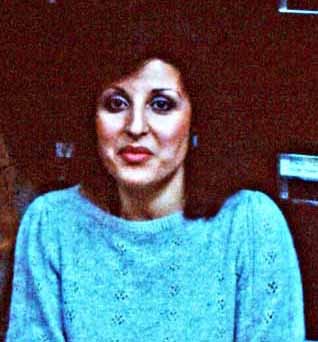 Angelina Genduso by Albert DeGuzman, 1984.
Angelina Genduso by Albert DeGuzman, 1984.
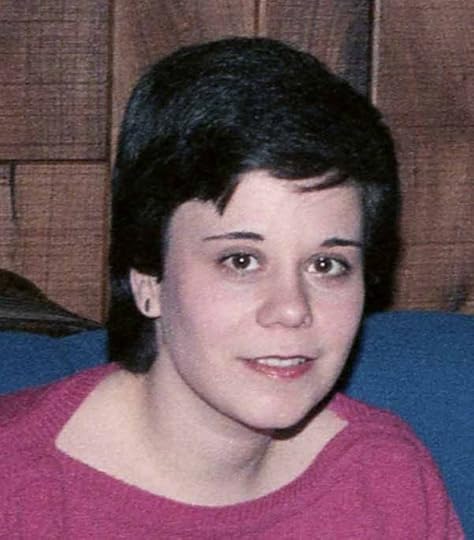 Denise (Vozzo) Conaty by Albert DeGuzman, 1985.
Denise (Vozzo) Conaty by Albert DeGuzman, 1985.
On the left from the entrance hall was an office for Angelina Genduso, Denise Vozzo and Bonnie Miller. Angelina recalls:
“After a few months that we were at 666, the International Rights Dept was brought in-house with the hire of Chantal D’Aulnis and I transferred to working with her, because of my knowledge of foreign languages, as her assistant. At the time, I shared my office (if you could call it that, it was so small) with two other girls: Denise Vozzo-Conaty and Bonnie Miller. Both reported to Bruce Bristow, Marketing.”
Around 1984, Angelina moved to the Special Projects department under Joe Orlando.
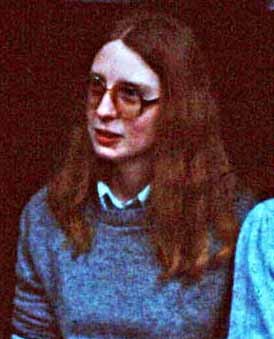 Dee Nelson by Albert DeGuzman, 1984.
Dee Nelson by Albert DeGuzman, 1984.
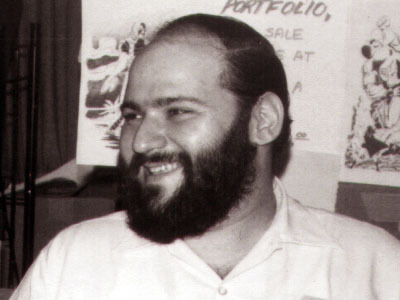 Mark Hanerfeld, photo by Mark Evanier, 1970s.
Mark Hanerfeld, photo by Mark Evanier, 1970s.
A left turn at the end of the entrance hall led toward the business and executive offices. On the left was the entrance to the DC Library, at that time with business person Dee Nelson in front of it. The library was then run by part-time employee and longtime fan Mark Hanerfeld.
 Midge Bregman, seen here in a 1985 photo by Albert DeGuzman, had a glass-windowed office overseeing this end of the main hallway as the Office Manager.
Midge Bregman, seen here in a 1985 photo by Albert DeGuzman, had a glass-windowed office overseeing this end of the main hallway as the Office Manager.
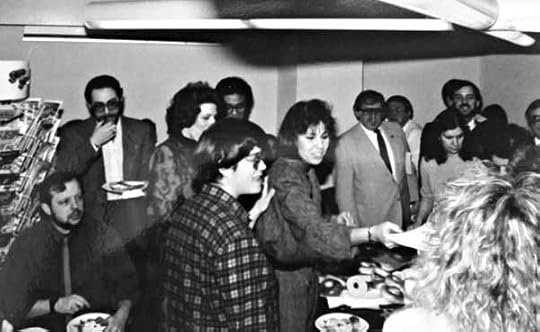 A left turn after Midge’s office and straight ahead brought you to the Conference Room, where monthly bagel parties were held to celebrate employee birthdays that month. In this post-1984 photo by Albert DeGuzman are Richard Bruning (seated), Bob Greenberger, Shelley Eiber in the checked shirt, Dick Giordano in the light jacket and tie, and others I’m not sure of. Company business meetings, staff meetings and other parties, like Julie Schwartz’s 1986 retirement party, were held here.
A left turn after Midge’s office and straight ahead brought you to the Conference Room, where monthly bagel parties were held to celebrate employee birthdays that month. In this post-1984 photo by Albert DeGuzman are Richard Bruning (seated), Bob Greenberger, Shelley Eiber in the checked shirt, Dick Giordano in the light jacket and tie, and others I’m not sure of. Company business meetings, staff meetings and other parties, like Julie Schwartz’s 1986 retirement party, were held here.
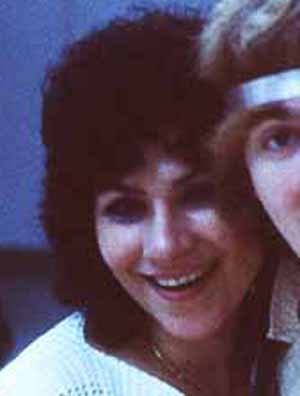 Carol Fein, in a 1984 photo by DeGuzman, was Publisher Jenette Kahn’s assistant, with her office between Jenette and the Conference Room. At some point she got her own assistant, Carlos Villanueva, who ran errands for her and Jenette. I don’t know where he sat.
Carol Fein, in a 1984 photo by DeGuzman, was Publisher Jenette Kahn’s assistant, with her office between Jenette and the Conference Room. At some point she got her own assistant, Carlos Villanueva, who ran errands for her and Jenette. I don’t know where he sat.
Jenette Kahn by DeGuzman, 1985.
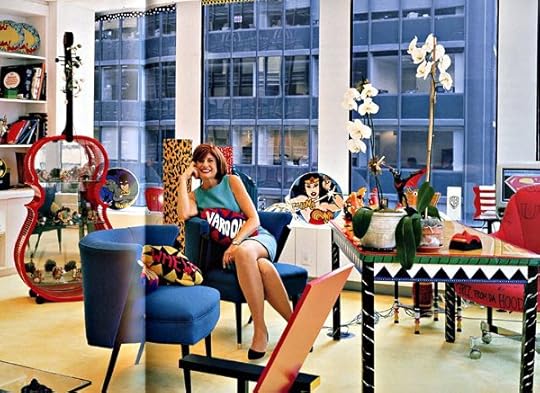 Jenette Kahn in her office at 1325 Ave. of the Americas, 1990s, but possibly with some of her office furniture from 666 5th Avenue. Photo found online.
Jenette Kahn in her office at 1325 Ave. of the Americas, 1990s, but possibly with some of her office furniture from 666 5th Avenue. Photo found online.
DC Comics President Jenette Kahn had the large corner office, as fitting for the head of the company, where she met with her staff, business and media contacts, and artist friends like Andy Warhol and Milton Glaser, who designed the DC symbol as well as, reportedly, the yellow-dotted wallpaper everyone remembers. We’ll see it later.
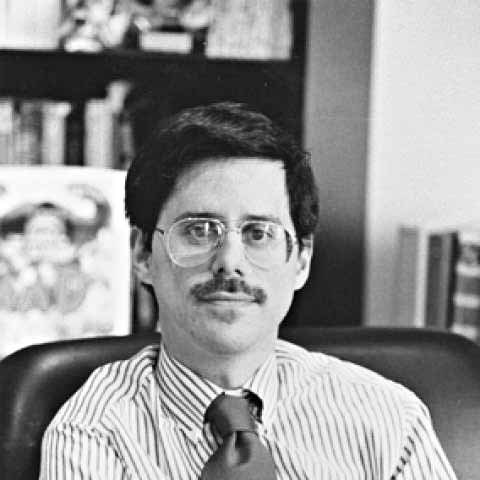 Paul Levitz, in an undated photo found online, had the second largest office in his role as the executive in charge of the business side of the company, with the title of Executive Vice President during the 666 years. Paul later became President and is well known for his comics writing.
Paul Levitz, in an undated photo found online, had the second largest office in his role as the executive in charge of the business side of the company, with the title of Executive Vice President during the 666 years. Paul later became President and is well known for his comics writing.
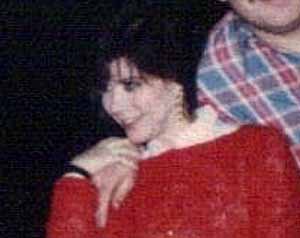 His assistant in the early days there was Robin Phelps, seen here in a photo by DeGuzman, 1985, the best I can find.
His assistant in the early days there was Robin Phelps, seen here in a photo by DeGuzman, 1985, the best I can find.
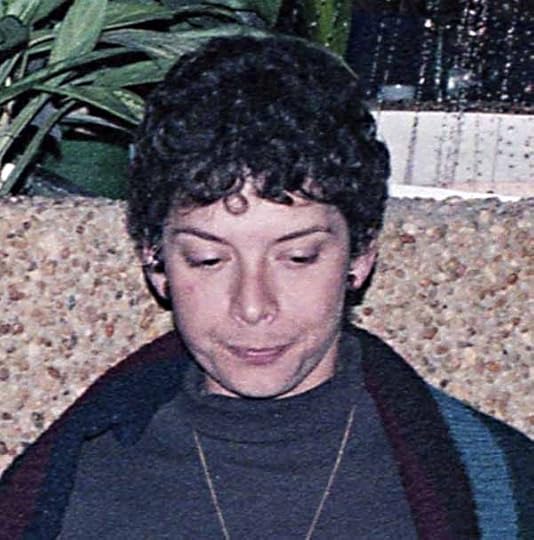 Charles McDade, Bruce Bristow and Chantal d’Aulnis in 1985 photos by DeGuzman.
Charles McDade, Bruce Bristow and Chantal d’Aulnis in 1985 photos by DeGuzman.
Filling out the business window offices were Charles McDade, Business Affairs; Bruce Bristow, Marketing; and Chantal d’Aulnis, International Rights.
 Another person on the Marketing team I can’t place in a room is Corinda Carford, seen here in a photo from her website. Corinda is a successful singer and now goes by her original family name of Carfora.
Another person on the Marketing team I can’t place in a room is Corinda Carford, seen here in a photo from her website. Corinda is a successful singer and now goes by her original family name of Carfora.
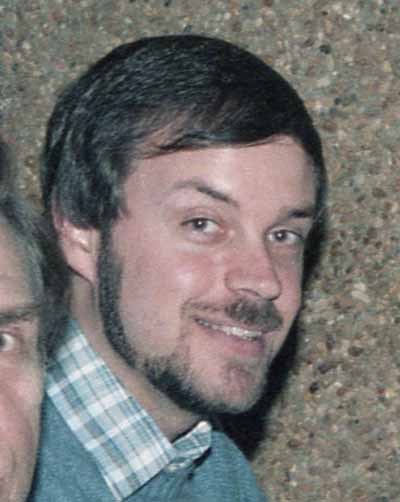 Arthur Gutowitz, Diane Perla and Tom Pattison in 1985 photos by DeGuzman.
Arthur Gutowitz, Diane Perla and Tom Pattison in 1985 photos by DeGuzman.
Of the Accounting Department on the 9th floor, I recall and have photos of three I’m sure of: department head Arthur Gutowitz, and his employees Diane Perla and Tom Pattison.
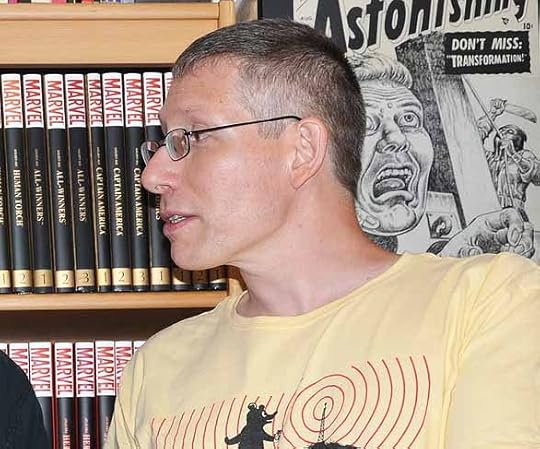 Nick Caputo from his blog, photo by Barry Pearl.
Nick Caputo from his blog, photo by Barry Pearl.
Nick Caputo wrote about working in the DC mailroom on the 9th floor:
“I began working in the mailroom of WPS (Warner Publishing Services) the month before the move to 666 Fifth. The mailroom on the 9th floor serviced DC as well as everyone on 9, but the main mailroom remained at 75 Rock, meaning we would have to transport the mail to and fro, from freight elevators, out to the street (rain or shine) and to the 75 rock freight elevator a few times a day. Quite a job! I remember many of the faces from DC, since I and my co-workers, Ben Valdez and Ronnie Grant, delivered their mail.”
Thanks, Nick, for filling me in on an area of the company I never visited and knew nothing about! We’ll continue with more of the early 666 staff and offices next time. Other articles on DC Comics history you might enjoy can be found on my COMICS CREATION page.
July 29, 2016
Title and Cover Design for Neil Gaiman’s AMERICAN GODS
On February 3rd of this year I received an email from Tom Egner, the art director for Avon Books, a division of Harper Collins publishing. He wrote:
“I’m interested in having you hand letter four Neil Gaiman book titles . The illustrations are being done by the very well known Bob McGinnis. Neil would like the lettering to have the vintage feel of pulp covers to complement the retro look of the art. I’m hoping that you are interested in creating the lettering.”
I was familiar with and loved the work of legendary cover artist Robert McGinnis, probably most famous for his James Bond paintings, but didn’t know that he was still alive and working. Mr. Egner and I spoke on the phone about the project, which I was happy to agree to, and I also corresponded with Neil about it. Neil wrote:
“What I’d love is if you can design the whole cover in each case, so all the lettering is of a piece, including the tag lines. The brief is, it’s 1966 and these are cult underground bestsellers, and you are selling them to the curious, I guess.”
I thanked Neil for asking that I get involved, and I told both Neil and Tom that I was amazed and excitied to be working with new art by McGinnis, and that I would pore over sixties paperbacks with and without McGinnis covers and see what I could come up with. At the Harper-Collins end, the project was transferred to Gail Dubov, and I worked with her thereafter, but always showing things to Neil first to get his feedback. You can read about how the project came to be in this BLOG POST FROM NEIL.
 Here are the first two title ideas sketched in pencil. The top one is more free-form and typical of many 1950s to 1970s genre paperbacks (crime, thriller, science fiction and so on). The second works around a medieval black-letter style for GODS, something you might have seen on 1970s fantasy paperbacks.
Here are the first two title ideas sketched in pencil. The top one is more free-form and typical of many 1950s to 1970s genre paperbacks (crime, thriller, science fiction and so on). The second works around a medieval black-letter style for GODS, something you might have seen on 1970s fantasy paperbacks.
 I also did this title version with marker on rough watercolor paper to add lots of texture, as suggested by a few 1950s paperbacks I found.
I also did this title version with marker on rough watercolor paper to add lots of texture, as suggested by a few 1950s paperbacks I found.
 Harper-Collins had sent me a scan of the amazing McGinnis painting and the book size, as well as the taglines they wanted to use, and I put together the first versions using the three titles I’d made (scanned and traced in Adobe Illustrator) with fonts I thought were appropriate for the time and concept. I also recreated the Avon Fantasy logo from the 1960s, which I thought would be a cool added element.
Harper-Collins had sent me a scan of the amazing McGinnis painting and the book size, as well as the taglines they wanted to use, and I put together the first versions using the three titles I’d made (scanned and traced in Adobe Illustrator) with fonts I thought were appropriate for the time and concept. I also recreated the Avon Fantasy logo from the 1960s, which I thought would be a cool added element.
 I chose to keep the colors neutral on these first versions to put the focus on the title and type styles.
I chose to keep the colors neutral on these first versions to put the focus on the title and type styles.
 This version didn’t work as well as I’d hoped. The angle on the title is too pronounced, and the letters are uneven.
This version didn’t work as well as I’d hoped. The angle on the title is too pronounced, and the letters are uneven.
After comments from Neil and Gail, as well as others at Harper-Collins, it was decided that the title and fonts in Version A were what they liked best, but Neil wanted to see a variety of different colors used, and also supplied a few more taglines to try.
 Here’s a version with yellows.
Here’s a version with yellows.
 One adding orange picked up from the distant sunset colors in the background and a new tagline.
One adding orange picked up from the distant sunset colors in the background and a new tagline.
 Another new tagline that became the final choice, and lavenders.
Another new tagline that became the final choice, and lavenders.
 This tagline, “A storm is coming,” was my favorite, but I and others felt it was too “on the nose,” since we see an actual storm in the art. Incidentally, of the other tagline, “The Bestselling Underground Novel,” as Neil said: “We looked at taglines from 60s paperbacks. I think that came from STRANGER IN A STRANGE LAND.” It did come from an early paperback printing of the Robert Heinlein classic.
This tagline, “A storm is coming,” was my favorite, but I and others felt it was too “on the nose,” since we see an actual storm in the art. Incidentally, of the other tagline, “The Bestselling Underground Novel,” as Neil said: “We looked at taglines from 60s paperbacks. I think that came from STRANGER IN A STRANGE LAND.” It did come from an early paperback printing of the Robert Heinlein classic.
 Neil had asked for strong colors, and here I pulled that dark orange-red from the sunset background on the right. Neil loved this color scheme, and with a change of the second tagline, I was ready to make the final version and send it in. Unfortunately, the publisher nixed my Avon Fantasy logo, as they only use the Avon imprint now on romance novels.
Neil had asked for strong colors, and here I pulled that dark orange-red from the sunset background on the right. Neil loved this color scheme, and with a change of the second tagline, I was ready to make the final version and send it in. Unfortunately, the publisher nixed my Avon Fantasy logo, as they only use the Avon imprint now on romance novels.
 Here’s the final cover as recently unveiled by Harper-Collins and Neil. H-C has added a new tagline at the bottom, but otherwise it’s as I sent it. I’m thrilled to be a part of this project, and have already worked on several more Gaiman cover designs, and I’m not finished yet. When they’re announced and revealed, I’ll write about them here.
Here’s the final cover as recently unveiled by Harper-Collins and Neil. H-C has added a new tagline at the bottom, but otherwise it’s as I sent it. I’m thrilled to be a part of this project, and have already worked on several more Gaiman cover designs, and I’m not finished yet. When they’re announced and revealed, I’ll write about them here.
July 27, 2016
Incoming: NEW ROMANCER
Image © Peter Milligan & Brett Parson.
Another recent Vertigo series I enjoyed lettering. It’s been decades since I worked with writer Peter Milligan (on SHADE, THE CHANGING MAN), and I wasn’t sure what to expect, but he did a fine job with this romantic comedy. Lord Byron brought back from the past to be a draw for an online dating service? Fun idea. Not to mention the complications of other famous lovers like Mata Hari and Casanova, and more modern schemers, all out to ruin the unlikely pairing of programmer Lexy Ryan and Byron himself. Should be out soon, and complete in this collection.
July 23, 2016
And Then I Read: WONDER WOMAN #1
The beginning of an interesting new approach, in this comic. Not only new for the character, but a new storytelling device. This issue follows Wonder Woman of today, continuing from the Rebirth one-shot. Next issue will be about Wonder Woman’s first year in man’s world. Both stories will continue in alternate issues.
Here’ Diana is in the African jungle on a mission that gradually becomes clear. She’s searching for someone that she thinks can help her with a serious problem. Someone who doesn’t want to be found, and sends fierce beasts and warriors to stop Diana. Meanwhile, a new version of Etta is working a communications command in touch with Steve Trevor, also in Africa on a secret mission. Both of them are wondering what Wonder Woman is doing in the same arena, but they have no answers. Neither has talked to her in a while.
Good set up, lots of action. The writing by Greg Rucka has me wanting more. The art by Liam Sharp is rich and delicious. Waiting to see what the other story line is like, but so far I’m on board.
Recommended.
July 21, 2016
Lettering for Entertainment Weekly 2016
 Out now on newsstands and digitally is the ENTERTAINMENT WEEKLY Comic-Con Preview 2016 issue with my lettering on the cover (Dark Tower) and inside. Here’s more about it.
Out now on newsstands and digitally is the ENTERTAINMENT WEEKLY Comic-Con Preview 2016 issue with my lettering on the cover (Dark Tower) and inside. Here’s more about it. On June 22nd I received an email from Jennie Chang, a staff designer at EW asking if I’d have time to do some work for her again. I’d lettered a title for their 2015 Comic-Con Preview, above, and wrote about it HERE. I enjoyed working with Jennie and her boss Creative Director Tim Leong last year, and was happy to agree. This time they wanted more from me, three section titles: Movies, TV and Comics, each to be done in the style of a well-known comics logo. Jennie was sure they wanted Movies in the style of the Superman logo, and we worked out the other two in back and forth emails: TV would mimic X-Men, and Comics would copy The Hulk. I got to work doing sketches.
On June 22nd I received an email from Jennie Chang, a staff designer at EW asking if I’d have time to do some work for her again. I’d lettered a title for their 2015 Comic-Con Preview, above, and wrote about it HERE. I enjoyed working with Jennie and her boss Creative Director Tim Leong last year, and was happy to agree. This time they wanted more from me, three section titles: Movies, TV and Comics, each to be done in the style of a well-known comics logo. Jennie was sure they wanted Movies in the style of the Superman logo, and we worked out the other two in back and forth emails: TV would mimic X-Men, and Comics would copy The Hulk. I got to work doing sketches.
Movies would imitate the 1983 Milton Glaser revamp of the Superman logo, above, which I am very familiar with. I’ve created lots of logos based on it.
 I worked out the details in pencil on my drawing board, and then made this marker sketch, which was quickly approved.
I worked out the details in pencil on my drawing board, and then made this marker sketch, which was quickly approved.
 I brought the scan above into Adobe Illustrator and traced the shapes with the pen tool to create this very precise vector version, then added color and sent it in. EW was delighted.
I brought the scan above into Adobe Illustrator and traced the shapes with the pen tool to create this very precise vector version, then added color and sent it in. EW was delighted.
 Here’s how it looks in print with color changes.
Here’s how it looks in print with color changes.
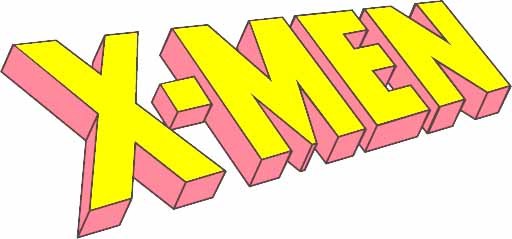 For TV we’d settled on the X-Men logo designed by Jim Steranko, and I found this version online to imitate. This was a more difficult task because TV is so much shorter than X-MEN, and I don’t know if many people will see the resemblance, but I did my best. I asked if I could add a hyphen between T and V to make the resemblance better, but that was nixed.
For TV we’d settled on the X-Men logo designed by Jim Steranko, and I found this version online to imitate. This was a more difficult task because TV is so much shorter than X-MEN, and I don’t know if many people will see the resemblance, but I did my best. I asked if I could add a hyphen between T and V to make the resemblance better, but that was nixed.
 Here’s my marker sketch, which was approved.
Here’s my marker sketch, which was approved.
 And my vector version created in Adobe Illustrator. Since there are no curves, this one went much more quickly!
And my vector version created in Adobe Illustrator. Since there are no curves, this one went much more quickly!
 For Comics, we decided on the Incredible Hulk logo designed by Herb Trimpe, above. I think it’s the most distinctive version, and EW wanted three-dimensional titles.
For Comics, we decided on the Incredible Hulk logo designed by Herb Trimpe, above. I think it’s the most distinctive version, and EW wanted three-dimensional titles.
 I sketched this one in pencil for approval, which was given…
I sketched this one in pencil for approval, which was given…
 …then inked it on paper. I felt that would be quicker and more effective than tracing it in Illustrator.
…then inked it on paper. I felt that would be quicker and more effective than tracing it in Illustrator.
 I auto-traced the inked version in Illustrator, did a fair amount of tweaking and cleanup, and added color. EW was happy with all of these.
I auto-traced the inked version in Illustrator, did a fair amount of tweaking and cleanup, and added color. EW was happy with all of these.
 Here it is in print. Not sure I like the color choices, but it pops nicely. A day or two later, Jennie contacted me again and asked if I’d have time for two more, a movie and a TV show title. I agreed.
Here it is in print. Not sure I like the color choices, but it pops nicely. A day or two later, Jennie contacted me again and asked if I’d have time for two more, a movie and a TV show title. I agreed.
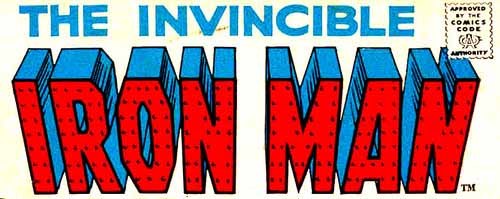 The movie was Blade Runner, and they wanted it in the style of this Iron Man logo.
The movie was Blade Runner, and they wanted it in the style of this Iron Man logo.
 I did this pencil sketch, which was approved…
I did this pencil sketch, which was approved…  …and I worked it up with the pen tool in Illustrator, then added color.
…and I worked it up with the pen tool in Illustrator, then added color.
 Here it is in the magazine, with color changes. I’m not sure how appropriate it is for the film, but it adds energy to the magazine layout.
Here it is in the magazine, with color changes. I’m not sure how appropriate it is for the film, but it adds energy to the magazine layout.
 The TV show was American Gods, and Jennie had some ideas, but I didn’t think any of them sounded appropriate, and I suggested using Alex Jay’s Thor logo as the inspiration. They agreed. This one, being all curves, much longer than the original, and sharing only two letters was the most difficult of the lot, but a fun challenge.
The TV show was American Gods, and Jennie had some ideas, but I didn’t think any of them sounded appropriate, and I suggested using Alex Jay’s Thor logo as the inspiration. They agreed. This one, being all curves, much longer than the original, and sharing only two letters was the most difficult of the lot, but a fun challenge.
 My pencil sketch, done on one line, but shown here on two to make it larger. It was approved.
My pencil sketch, done on one line, but shown here on two to make it larger. It was approved.
 Here’s my vector version done in Illustrator…
Here’s my vector version done in Illustrator…
 …and here it is in print. I think it’s my favorite, and both Alex Jay and Neil Gaiman seemed to like it when I shared it with them, which made me happy.
…and here it is in print. I think it’s my favorite, and both Alex Jay and Neil Gaiman seemed to like it when I shared it with them, which made me happy.
 A detail from the printed version.
A detail from the printed version.
So, I thought I was done and send in my invoice, but the NEXT day I got another call: could I design three more titles for Stephen King’s Dark Tower, an upcoming TV series? Now the deadline was tight, I would have to turn them around quickly. Jennie suggested I do them all using rough, scary letters inspired by the original Swamp Thing logo. I agreed, though what I did isn’t really very close to the inspiration.
 EW supplied the layouts exactly as they wanted them, and working over those on my light box, I sketched out some scary letters in pencil, then went right to ink with a brush, the quickest method to get there. The trick was to get the points sharp enough, and it took time, but was still quicker than inking with pens. Some pencil can be seen on the edges here, which was erased before scanning.
EW supplied the layouts exactly as they wanted them, and working over those on my light box, I sketched out some scary letters in pencil, then went right to ink with a brush, the quickest method to get there. The trick was to get the points sharp enough, and it took time, but was still quicker than inking with pens. Some pencil can be seen on the edges here, which was erased before scanning.
 For the main spread in the magazine, this was the layout they gave me, with ornaments drawn roughly by me from details on the guns of the main character. I auto-traced my inked work in Illustrator and they loved it.
For the main spread in the magazine, this was the layout they gave me, with ornaments drawn roughly by me from details on the guns of the main character. I auto-traced my inked work in Illustrator and they loved it.
 Here’s how it looks in the magazine, with three-dimensional telescoping added by them in Photoshop.
Here’s how it looks in the magazine, with three-dimensional telescoping added by them in Photoshop.
 The other two titles were “Stephen King’s Dark Universe” and “The Dark Tower.” I did Dark Universe, then added the only two missing letters for the other title, W and O. The rest I would comp together in Illustrator.
The other two titles were “Stephen King’s Dark Universe” and “The Dark Tower.” I did Dark Universe, then added the only two missing letters for the other title, W and O. The rest I would comp together in Illustrator.
 Here’s Dark Universe in print with Photoshop effects. Looks fine to me.
Here’s Dark Universe in print with Photoshop effects. Looks fine to me.
 And this is what I turned in for The Dark Tower, which they used on the cover, dropping THE in favor of a small type version to make the titles larger. I approve!
And this is what I turned in for The Dark Tower, which they used on the cover, dropping THE in favor of a small type version to make the titles larger. I approve!
These last titles were rushed, and I would have tweaked them in Illustrator if I had time, but maybe it’s just as well I didn’t, they look fine to me in print. It was fun working for ENTERTAINMENT WEEKLY, perhaps they’ll ask me again next year.
July 20, 2016
Incoming: THE ILLEGALISTS and LUCIFER
Another new Vertigo series that I’m enjoying lettering. I think writer Holly Black is doing a fine job, and I love the art of Lee Garbett. Don’t know if it’s anything like the TV show, haven’t seen it, but likely it’s not. Very much carrying on from the characters as Neil Gaiman and Mike Carey handled them.
 Here’s a new hardcover, a fantastic project I’ve been working on the last few years, whenever Stefan Vogel could afford to produce more of it. The story of the Bonnot Gang in early 20th century Paris. Working folks lashing out at unfair laws, police brutality and poverty by becoming the Paris version of the Bonnie and Clyde gang…sort of. It’s an exciting and well-told story based on true events. I’m not sure if you can get the English language version if you didn’t back the Kickstarter, but there’s a Facebook page where you might ask. There will be a French language version next year. And if you watch my eBay auctions…
Here’s a new hardcover, a fantastic project I’ve been working on the last few years, whenever Stefan Vogel could afford to produce more of it. The story of the Bonnot Gang in early 20th century Paris. Working folks lashing out at unfair laws, police brutality and poverty by becoming the Paris version of the Bonnie and Clyde gang…sort of. It’s an exciting and well-told story based on true events. I’m not sure if you can get the English language version if you didn’t back the Kickstarter, but there’s a Facebook page where you might ask. There will be a French language version next year. And if you watch my eBay auctions…
July 18, 2016
And Then I Read: STAR RANGERS by Andre Norton
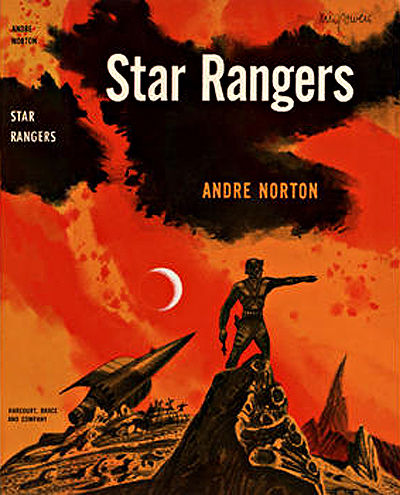 Another early science fiction novel by Norton that I missed all these years, first published in 1953, and loosely connected to “Star Guard,” reviewed here recently. This book takes place about 4,000 years later as the galactic empire described in the first book is falling apart. The Stellar Patrol, populated by beings from many worlds and serving as a police force, has been falling apart as well, their ships degrading and barely working. One such ship, among many, the Starfire, has been sent to the edge of the galaxy supposedly in search of lost systems and colonies, but in fact as a way to get rid of them. The ship crashes on an Earthlike world, and though the Captain is injured and unable to accept the truth, will never fly again. On board are a group of Star Rangers, the exploration team of the ship, with two human members, and the rest “bemmies,” or non-human aliens, all with powerful mental and physical skills, but treated with suspicion by the rest of the crew.
Another early science fiction novel by Norton that I missed all these years, first published in 1953, and loosely connected to “Star Guard,” reviewed here recently. This book takes place about 4,000 years later as the galactic empire described in the first book is falling apart. The Stellar Patrol, populated by beings from many worlds and serving as a police force, has been falling apart as well, their ships degrading and barely working. One such ship, among many, the Starfire, has been sent to the edge of the galaxy supposedly in search of lost systems and colonies, but in fact as a way to get rid of them. The ship crashes on an Earthlike world, and though the Captain is injured and unable to accept the truth, will never fly again. On board are a group of Star Rangers, the exploration team of the ship, with two human members, and the rest “bemmies,” or non-human aliens, all with powerful mental and physical skills, but treated with suspicion by the rest of the crew.
Human Ranger Sergeant Kartr is the viewpoint character of the book, from a world that has been destroyed in war, and very close to his Ranger team. Together they explore the area, finding plenty of plant and animal life to sustain the small surviving Patrol group. They also discover an ancient city that has been occupied by survivors of another crashed ship, run by a crafty politician, Joyd Cummi, who has seized control by force. Most of the Patrol wants to join this group, but the Rangers are skeptical, especially when it becomes clear their non-humans will be treated as second-class members or worse. Eventually a rebellion breaks out in the city, and Kartr and his team may be the only ones who can stop Cummi from destroying them all.
I enjoyed this. Norton is not a flashy writer, her plots and ideas are not remarkable by science fiction standards, but she tells a good story with memorable, sympathetic characters, and she makes good moral points here. Substitute Muslims or African Americans for the bemmies in the story, and it would become relevant to today. And there is a great plot point that resonates with our own history in the last third of the story that I won’t spoil for you.
Recommended.
Todd Klein's Blog
- Todd Klein's profile
- 28 followers


